




Sadly in 2023 we suffered the insurmountable loss of our good friend and valued colleague, Michael Pomeroy. Mike joined the University (formerly NIHE) in 1979 as a postdoctoral fellow, working with John Barnard in the Materials Engineering and Industrial Chemistry Department. In 1981, he expanded his research interests into the field of engineering ceramics, collaborating with Stuart Hampshire. He was recruited as a lecturer in Materials Science to support the new undergraduate programme of the same name in 1985. He was promoted to Associate Professor in 2000. Over the years, Mike lectured in a wide variety of Materials Science-related subjects, specifically the areas of ceramics and glass science, failure processes including fracture mechanics, phase equilibria, surface engineering, physical metallurgy and analytical techniques. He won the UL Excellence in Teaching award in 1994. He helped to create two successful taught MSc programmes with a strategically important materials theme.
He collaborated with many international academic institutes, including the Max Planck Institute in Dusseldorf, and his industrial collaborations with the likes of Corning, Aerogen and Rolls-Royce led to him being named on both European and US patents. Mike’s last paper was published in the International Journal of Applied Ceramic Technology. His contribution to the science of ceramics was acknowledged in 2016 by his appointment as a Fellow of the European Ceramics Society. He was a key member of the team involved in helping to establish the Materials and Surface Science Institute in the late 1990s. Mike was appointed Assistant Dean of Research in the College of Engineering in 2001 and served on the Governing Authority from 2014 until his retirement in 2017. When not engaged in academic activities, Mike was a devoted carillonneur and travelled widely in pursuit of his interest. Not surprisingly, Mike was acknowledged for his expertise in the bell-ringing community. Mike’s many friends and colleagues will remember his generous personality, his ready smile and his dedication to the university and its students.
 Micro corals in a petri dish, by Dr Anne Beaucamp Mc Loughlin and Dr Valeria Nico, 2nd place, Research Image of the Year
Cover image – Research Image of the Year Award Winner “Nature under the electron Beam” Nataly Rey and Githin Tom Zachariah
Micro corals in a petri dish, by Dr Anne Beaucamp Mc Loughlin and Dr Valeria Nico, 2nd place, Research Image of the Year
Cover image – Research Image of the Year Award Winner “Nature under the electron Beam” Nataly Rey and Githin Tom Zachariah

The year 2022 saw a successful post-pandemic transition back to campus, allowing a creative and collaborative acceleration, as the community could once again engage in the irreplaceable importance of personal interaction.

Research output has continued to impress, with sustained improvement in top-decile and top-quartile publication percentages. Our research quality is further underpinned by an increase in the number of ERC applications and our continued success in this important arena. The successful realisation of ambition reflects the growing confidence and performance of our early- and mid-career research leaders, proving that the research heart of Bernal beats strongly in a vibrant and diverse body.
The Supervisory Board (SVB) appreciates the leadership and mentorship from the Director and senior leaders, developing their key staff to assume ever more responsibility for cluster leadership. By way of example, the SVB would like to congratulate Paul Weaver on the outstanding results he and his team have achieved in the first five years of his Science Foundation Ireland (SFI) Professor’s Grant.
Critical to the future success of the institute is talent development. This requires many initiatives. The SVB would like to recognise the Director for the renewal and expansion of the institute’s leadership team as one important initiative. Rotating more staff into leadership responsibility, with a shorter, two-year cycle, should ensure a healthy succession pipeline and improve our diversity.
As a Pasteur’s Quadrant institute, we focus jointly on research excellence and societal impact. The year 2022 saw positive outcomes in invention disclosures and patents, but the expected follow-on activity in new company creation continues to lag. Our most

impressive contribution toward future national economic impact has come from our significant participation in the important West-Coast energy and cyclic economy initiative, Shannon 2.0.1 The Director’s role is to be commended and it places the institute and UL in a prime position for high-profile research engagements, commercial partnerships, and finally, new company creation (spinouts).
Looking forward through next year and beyond, the institute faces several key challenges, perhaps the most significant of which is the expected change in the National (SFI, IRC) landscape, in regard to the hosted centre model. The institute should be confident of its future, given the strong validation received by its centres from numerous prestige industry and academic partners. External QS department rankings have provided an important external confirmation of our contribution to the university. Beyond the external challenges, we need to prepare for internal change, in regard to the next institute cycle, and eventually, the planned Director succession. It is important that we do not lose momentum in 2023/2024 and continue to build on our achievements and execute to plan. Our strategic plan, which is to focus on disruptive technologies related to health, energy and the environment, guides our direction.
In closing, the SVB recognises the continued strong leadership from the Director, General Manager, and senior leaders, most especially, the delivery of outstanding results within a financially constrained system.
1 Department of Enterprise, Trade and Employment (2022), Shannon Estuary Economic Taskforce Interim Report.I am delighted to present the 2022 Bernal Report and I am looking ahead to 2023. Launched in November 2016, the Bernal Institute has shown remarkable institutional development, with a clear strategy, robust internal processes and structures, a second-to-none equipment infrastructure for materials research, excellent productivity and, most importantly, a very active and driven research community. This was explicitly mentioned in the 2022 Bernal Quality Review Report. Throughout 2022, we have consolidated our policies around research institutes and centres, many of which are inspired by the Bernal Institute’s pioneering work.

The strategic commitment of the Bernal Institute to sustainability in general and to grand challenges in health, energy and the environment are an excellent fit to, and deployment of, the UL Sustainability Framework. Bernal’s research programmes and hosted SFI Research and EI Tech Centres show how UL can deliver sustainable development far beyond its own footprint. The research impact is tangible in many industrial and societal sectors, through lifesaving pharmaceutical products; biomedical devices; circular materials; and renewable energy generation, storage and conversion systems. I am delighted to see the Bernal Institute increasingly interact with external stakeholders, especially through increased industry partnerships and by visible participation in the Shannon Estuary Economic Taskforce and international innovation centres, both within and beyond Europe. This places UL as a young research university and proud member of YERUN (Young European Research Universities Network) on the forefront of Wisdom for Action, the 2022–2027 Research Strategy of the University of Limerick.
The Bernal Institute is maturing and optimising its processes and structures to embrace the diverse talent pool in its research community. With pleasure, I’ve noted that in the current iteration of its leadership team, the diversity of gender, nationality and career stage reflects that of the broad Bernal research community, while keeping quality in research and leadership as a prime objective. I would also like to express my gratitude to the foundational members of the Bernal leadership team. Without your contribution
and firm commitment, the institute’s continued institutional development would not have been possible.

With all the grim developments in Eastern Europe, tangible climate change impacts and a concerning health and energy structure, I am however very optimistic on how the Bernal Institute will continue to contribute to ground-breaking scientific and engineering solutions. The Green Digital Strategy of the Irish government requires continued innovation, and most major innovations require advanced structured materials. With the Shannon region as its home and Living Lab, the impact of the Bernal Institute will be increasingly more visible in the region, in Ireland and beyond.
As an academic institute, our primary role is to nurture future leaders. Orienting them early in their education on quality, critical constructive thinking, entrepreneurial opportunities and crossdisciplinary teamwork to address grand challenges is essential. Therefore, I’m also delighted that the Bernal Institute with colleagues across campus, has been instrumental in developing the UL50 Sustainability Challenge. In their diverse projects, the five enthusiastic student finalist teams showed how research-led education can combine research excellence with impact in very concrete ways. By stimulating cross-disciplinary, cross-functional and cross-sectoral sharing and engagement, the Bernal Institute has become a lasting positive contributor to the university ecosystem.
I thank the Director and the whole Bernal Team for their sustained commitment and wish them further success in 2023 and beyond. The continued growth of the Bernal Institute, as presented in this 2022 Report is our best guarantee to develop much needed disruptive solutions to global challenges in health, energy and the environment.
Prof. Kerstin Mey President, University of Limerick
The Bernal Institute prides itself on being the leading Irish institute for materials science and engineering research, addressing global challenges under three of the UN sustainable development goals: Health, Energy and the Environment.
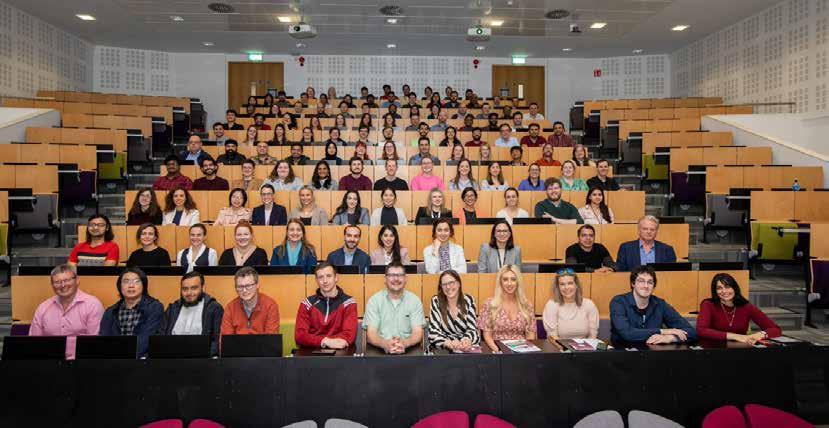
A community of over 400 researchers and support staff, drawn mainly from the disciplines of Chemistry, Physics, Biology and a range of Engineering domains (Biomedical, Aeronautical and Mechanical), Bernal delivers both fundamental understanding and applied solutions to a myriad of application areas, from automotive to pharmaceutical, from medical device to electronics, from dairy to aeronautical, and many more beyond. The agnostic nature of these applications is grounded in fundamental scientific understandings of the core research areas of composite, biological, molecular and nano materials, as well as a strong engineering focus addressing manufacturing process scale-up activities.
In 2022, greater emphasis in Bernal was placed on the development and support of early career researchers. Some of these are profiled in greater detail in this report. In Bernal, we have great hopes for their success over the coming years. Their research areas are very complementary to the current activities in Bernal and they bring a new dynamic to Bernal and to UL.
Bernal is the envy of all that visit, nationally and internationally, given the state of the art facilities and equipment that resides at the institute. The 20,000 m2 facility, comprising 91 laboratories, is home to the best in class material characterisation and manufacturing equipment, from Transmission to Scanning Electron Microscopy (TEM to SEM), from X-ray Diffraction to X-ray Photo-electron Spectroscopy (XRD to XPS), from Focused Ion Beam Spectroscopy to Atomic Force Microscopy (FIB to AFM). These are complemented by a range of laboratory to small research pilot-scale suites for pharmaceutical, thermochemical, nano-technological and robotic composites materials manufacturing. These core instruments and suites are maintained and supported by a dedicated team of instrument scientists, who consistently tutor our researchers and support the delivery of high-impact journal publications, while also assisting our industry partners in their trouble-shooting and research needs. In 2022, Bernal successfully leveraged the SFI infrastructures programme to fund four additional large-scale infrastructure awards. These will enhance our world-renowned capabilities in the areas of batteries research, novel composite materials manufacture, enhanced TEM capability and greater process engineering scale-up and analysis.
Given the breadth and depth of the research activities, it is vital that we identify cross-cutting themes that enable collaboration across disciplines. One such area where commonality can be achieved is in the area of modelling. In this report, we give a snapshot of the variety of modelling activities that take place within Bernal, which is truly eye-opening and lends the perfect opportunity for convergence across application areas.
This year, we also welcomed back events that we have not been in a position to support, since the pandemic arrived in 2020. Specifically, we hosted the Bernal Research and Industry days in April and December respectively. The research day, AStruM 2022, was the first face-to-face meeting of the community in over two years. The theme was ‘The Circular Economy’ and it was a pleasure to have Ossian Smith TD, Minister of State at the Department of Public Expenditure and Reform with responsibility for Public Procurement, eGovernment and Circular Economy, come to address our staff and students and debate the future of the industry with taught leaders in that space. Our second ever Industry Day was incredibly well supported with seven industry leaders addressing our community, with a wide range of companies coming to Bernal to meet with our students and tour the facilities. We had excellent presentations and a mini-recruitment fair on the day, with in-depth discussions on ‘Opportunities for the future’.
An appropriate governance model is vital to the success of all organisations and Bernal is no different in this regard. This year, UL rolled out its Research Institutes and Centres policy, which is strongly informed by the pioneering Bernal model. Key attributes of that model include: the roles, terms and succession of external boards, as well as Institute membership and dual line management. It incorporates key aspects of the multidisciplinary research environment such as personal/talent development. This addresses a number of recommendations by the Bernal International Quality Review Group in November 2021. A range of followup actions in conjunction with departments and schools are planned for 2023 to enhance research performance. This includes collaboration on project information sharing, recruitment and hiring, and additional research supports. It also formed the basis for the multi-annual budget process for 2023–2027, dealing with costs of the growing equipment infrastructure (around €50 million replacement value), as well as with the enhanced professionalisation of pre- and post-award support.
With the aforementioned developments, the Bernal Institute is fully on track in the last stages of the Implementation Phase following the ‘Fraunhofer’ institutional development plan (Figure 1), to claim and evidence a national and international leadership role by 2024.
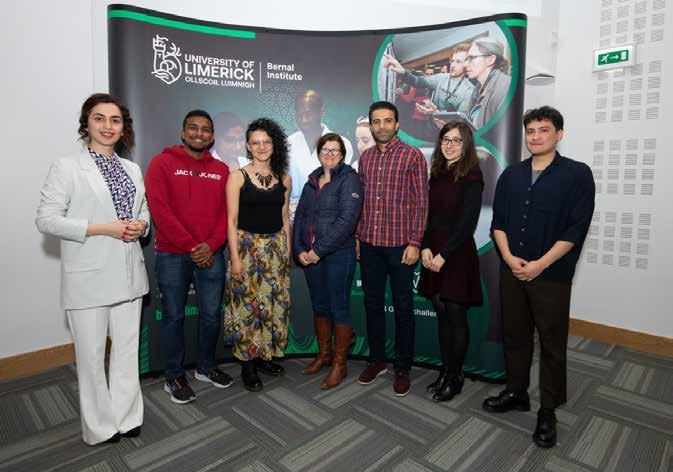
Industry partners alike. Our researchers, industry partners, students and external funding agencies shared and considered the future and all looked bright. In February there was, in the background, a sense that a tsunami was coming from the East but the hope was this would pass quickly. Then March 12th came and everything changed, changed utterly and yet another terrible beauty was born.
Industry partners alike. Our researchers, industry partners, students and external funding agencies shared and considered the future and all looked bright. In February there was, in the background, a sense that a tsunami was coming from the East but the hope was this would pass quickly. Then March 12th came and everything changed, changed utterly and yet another terrible beauty was born.
Like many organisations Bernal went into fight, as distinct from flight, recovery mode and while messages from the external environment; ‘research is an essential service’ to ‘Universities and Educational organisations should remain closed’ were conflicting, Bernal set about the challenge with gusto. It was the first entity in UL to return to work in early June and laid the pathway for others to follow. That energy and vitality is what we live by in Bernal and it is abound throughout the organisation.
Like many organisations Bernal went into fight, as distinct from flight, recovery mode and while messages from the external environment; ‘research is an essential service’ to ‘Universities and Educational organisations should remain closed’ were conflicting, Bernal set about the challenge with gusto. It was the first entity in UL to return to work in early June and laid the pathway for others to follow. That energy and vitality is what we live by in Bernal and it is abound throughout the organisation.


We are delighted to bring the first Bernal Institute report which demonstrates how, in a crisis, the spirit of the community has not only achieved targets, they have been surpassed beyond all expectations. This is evident in our publication quality and quantity in the year. Our renewed membership within 2020 has led the way here.
We are delighted to bring the first Bernal Institute report which demonstrates how, in a crisis, the spirit of the community has not only achieved targets, they have been surpassed beyond all expectations. This is evident in our publication quality and quantity in the year. Our renewed membership within 2020 has led the way here.

We continue our robust strategy, ‘Structures Matter’, targeting grand challenges in health, energy and the environment. In the health domain, we see robust growth in and across clusters in pharmaceuticals and delivery systems, cancer diagnosis and therapeutics, reproduction and urology. This includes a refresh of the SSPC leadership, growth of the Limerick Digital Cancer Research Centre, as well as intensive external partnerships with a range of leading Irish and international industries. For energy and the environment, we deliver significant outputs in renewable energy, materials and water conversion and storage, as well as emission reduction systems. We are engaged in significant national fora, especially through participation in the Shannon Estuary Economic Taskforce, delivering the Shannon Scheme 2.0 master plan, which has been strongly advocated by An Taoiseach and government ministers. Bernal is preparing for major next steps in 2023, especially through intensified industry and international partnerships.

This report gives a snapshot of some of the outstanding research that is taking place in Bernal. We also take some time to explain our strategy to become world leading in structured materials and on how we are tackling global grand challenges and UN sustainable development goals in the areas of Health, Energy and the Environment. In this report, we showcase just some of the 65 Principal Investigators (PIs) but there is a lot more happening than can be shared in a single report across our four research clusters of Bio Materials, Composite Materials, Molecular & Nano Materials and Process Engineering.
This report gives a snapshot of some of the outstanding research that is taking place in Bernal. We also take some time to explain our strategy to become world leading in structured materials and on how we are tackling global grand challenges and UN sustainable development goals in the areas of Health, Energy and the Environment. In this report, we showcase just some of the 65 Principal Investigators (PIs) but there is a lot more happening than can be shared in a single report across our four research clusters of Bio Materials, Composite Materials, Molecular & Nano Materials and Process Engineering.
All research inputs must lead to tangible and impactful outputs. To that end, the institute is assessed in terms of the key performance indicators (KPIs) it delivers. These continue to go from strength to strength in key areas of publication (quality and quantity), with growth in PhD numbers and research funding. The institute continues to grow on all its metrics since its establishment in 2016.
the careers of the academics and industrialists of the future. We acknowledge that group in particular for their continued dedication and exuberance for the role.
the careers of the academics and industrialists of the future. We acknowledge that group in particular for their continued dedication and exuberance for the role.
The year concluded with our first ever International Virtual Research Day where we reached out to 20,000 personnel globally. We had research presentations from colleagues from the UK, Germany, the US, Canada, Italy as well as Bernal colleagues. It was a day of celebration with our research awards to our community completing the day.
The year concluded with our first ever International Virtual Research Day where we reached out to 20,000 personnel globally. We had research presentations from colleagues from the UK, Germany, the US, Canada, Italy as well as Bernal colleagues. It was a day of celebration with our research awards to our community completing the day.
We look at 2021 and future years with enthusiasm. Internally we have great plans for revitalising teaching programmes at under and post graduate level across departments within UL. We are targeting significant EU programmes at the Excellent Science level while also engaging with our chosen Industry partners on international and national platforms. Our support team and Instrument Scientists are, as always ready, willing and able to assist in all of the above.
We look at 2021 and future years with enthusiasm. Internally we have great plans for revitalising teaching programmes at under and post graduate level across departments within UL. We are targeting significant EU programmes at the Excellent Science level while also engaging with our chosen Industry partners on international and national platforms. Our support team and Instrument Scientists are, as always ready, willing and able to assist in all of the above.
As a community of over 40 different nationalities, 2022 has also seen a greater emphasis on equality, diversity and inclusion (EDI). As an institute in a traditional academic setting, we are especially aware of the importance of EDl. In December 2022, an EDI committee was formed, with the task of working with the entire community to drive change, challenge issues and take action. This will be done by designing and introducing initiatives that will create an engaging, multicultural and diverse learning and working environment for all. This also finds its way into the formal Bernal structures and processes by expanding our supervisory board and restructuring the leadership team. The upcoming membership review in 2023 is a further opportunity to better reflect the institute’s diversity, as well as to enhance communication within the Bernal community. In conclusion, with continued focus on both the internal and external environment, in partnership with industry and regional collaborators within the changing Irish and EU research landscape, the Bernal Institute plans to deliver the strategic objective of being a recognised, proactive and impactful national and international player in 2023 and beyond.
Our cover photo is taken from our recently hosted International research day astrum.ie. Astrum is the Latin word meaning heavenly body or constellation. We invite you to come on this journey with us in Bernal as we ‘reach for the stars’.
Our cover photo is taken from our recently hosted International research day astrum.ie. Astrum is the Latin word meaning heavenly body or constellation. We invite you to come on this journey with us in Bernal as we ‘reach for the stars’.
Luuk van der Wielen Director Jon O’Halloran General Manager

 Luuk van der Wielen Jon O’Halloran Director General Manager
Luuk van der Wielen Jon O’Halloran Director General Manager
Luuk van der Wielen Jon O’Halloran Director General Manager
Luuk van der Wielen Jon O’Halloran Director General Manager
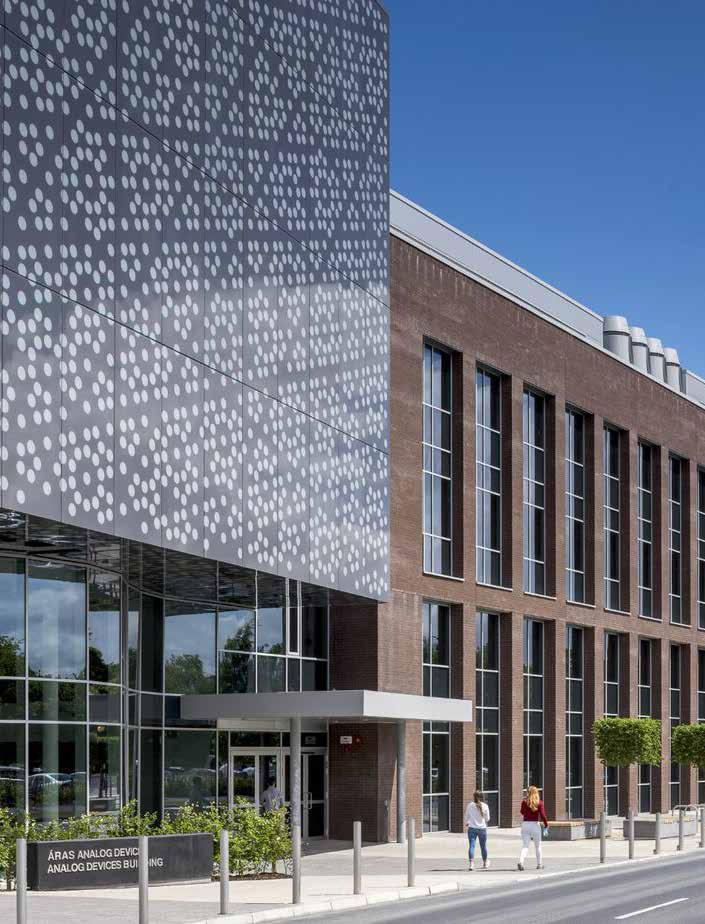

Dr Promita Bhattacharjee is conducting research that is integral to the €5 million project, ‘Therapeutic enzymes as a treatment for sepsis and other immune disorder diseases’. The project, funded by the Enterprise Ireland Disruptive Technologies Innovation Fund, was awarded to Prof. Sarah Hudson of Cala Medical in 2018. Its aim is to utilise immunomodulatory enzymes (IMEs) in commercially viable therapies for treatment of autoimmune diseases, with the first focus on psoriasis and rheumatoid arthritis. These IMEs were formulated and tested to establish their potential for commercial exploitation as well as to develop innovative delivery systems for the targeted disease areas.
Globally, 125 million people live with psoriasis and in Ireland, 6,000 people are affected per year. This number is potentially increasing annually. Current drugs in the market have several limitations, most of which cause side effects such as asthma, and treat the symptoms only. Discovering new drugs specifically targeting the immunological pathway can serve humanity immensely.
The immunomodulatory enzyme we are working with is called ScpA (A streptococcal C5a peptidase).
ScpA is a bacterial protein that has the potential to decrease the inflammation associated with different cytokines, which are very small proteins, generally 5-25kDa, that interact with cells through receptors and generate cell signals that mediate cell–cell interaction.
Simply, cytokines are small-size proteins in the human body that are responsible for activating the immune system. However, the higher expression of cytokines are harmful to the human body, causing autoimmune diseases. The human immune system is very complex. So far, we tested ScpA against four major cytokines that are responsible for inducing inflammation in the human body: Interferon gamma, Type 1 T helper groups of cytokines, Type 17 T helper groups of cytokines and the complement component group of cytokines. Figure 2 clearly indicates that ScpA successfully reduced the inflammation associated with these cytokines.
Promita’s research could very well form an important part of standard therapeutics, or inspire the development of such therapeutics, over the next five to ten years. They could dramatically improve the quality of life for the millions living with autoimmune disorders like psoriasis.

• Keratinocytes are stratified and well defined.
• Stratum corneum is closely packed.
• Stratum corneum is damaged.’
• Nucleus were arranged and came down from the stratum corneum.
• Stratum corneum started to rescue their structure to healthy epidermis phenotype.

Dr John Mulvihill and Mannthalah Abubaker have made great strides this year in highlighting the importance of the cells that form barriers to the brain. As it is one of our most integral organs, humans have evolved to place utmost importance on the brain’s protection. To ensure that it is shielded from harm, our bodies have developed various types of barriers that restrict the entry of unwanted substances.
These barriers are now being recognised as critical components of our overall health, and the disruption of these barriers has been linked to the onset of several neurodegenerative diseases, such as Alzheimer’s, Parkinson’s and ALS. Unfortunately, these disorders still lack effective treatment options, and the United Nations estimates that by 2050, 153 million individuals will be living with dementia.
To further our understanding of these barriers, it is important to study how they function, why they exist and what factors can lead to their dysfunction. Researchers at Bernal have especially developed a keen interest in meningeal barriers. These consist of three integral membranes that protect and cushion the brain and spinal cord, while preventing toxins from infiltrating from other tissues. We believe that by studying the meningeal barriers, we can uncover a missing link in our understanding of the brain, particularly in cases of injury or disease.
One critical aspect of meningeal barriers is their interaction with cerebrospinal fluid (CSF), a specialised fluid that provides a protective cushion for the brain and spinal cord. CSF also supplies essential nutrients to the central nervous system
(CNS) and facilitates the transport of immune cells and waste products in and out. Recent studies have shown that the flow of CSF, including its speed and volume, can impact CNS health and may be linked to the onset of neurodegenerative diseases.
To achieve their research goal, John and Mannthalah are focusing attention on the cells that form the meninges, known as leptomeningeal cells. These are a unique subset of cells that contain a wide range of characteristics, including that of fibroblasts and endothelial cells. By studying the leptomeningeal cells in depth, we can uncover new insights into their role in protecting the brain and spinal cord from injury and disease. One of our primary hypotheses is that leptomeningeal cells are mechanosensitive to the flow of the CSF. This means that they can respond to different situations, based on the amount and speed of fluid flowing around them. By studying the mechanosensitivity of these cells, we can gain a deeper understanding of how they function under different conditions, which could be a critical point in the overall response of the CNS to all types of injury and disease.
Overall, the study of brain barriers and their interaction with CSF represents a critical area of research with far-reaching implications for our understanding of neurodegenerative disorders. As our knowledge in this field continues to expand, we may be able to identify new treatment strategies to combat these devastating conditions and improve the overall health and wellbeing of individuals affected by them.

UL Food Scientist, Dr Ioannis Zabetakis is formulating nutraceuticals and functional foods to prevent cardiovascular diseases (CVD), using nutrients found in salmon, yoghurt and cheese. He has identified nutrients in salmon and fermented dairy with strong anti-thrombotic activities that inhibit platelet aggregation, thrombosis and inflammation and hence, the onset of CVD.
Dr Zabetakis’ research seeks to understand the links between CVD and inflammation. CVD takes an estimated 17 million lives each year, according to the World Health Organization. The use of statins to lower blood cholesterol in humans does not decrease the cardiovascular risk. Also, omega-3 supplements are ineffective against CVD.


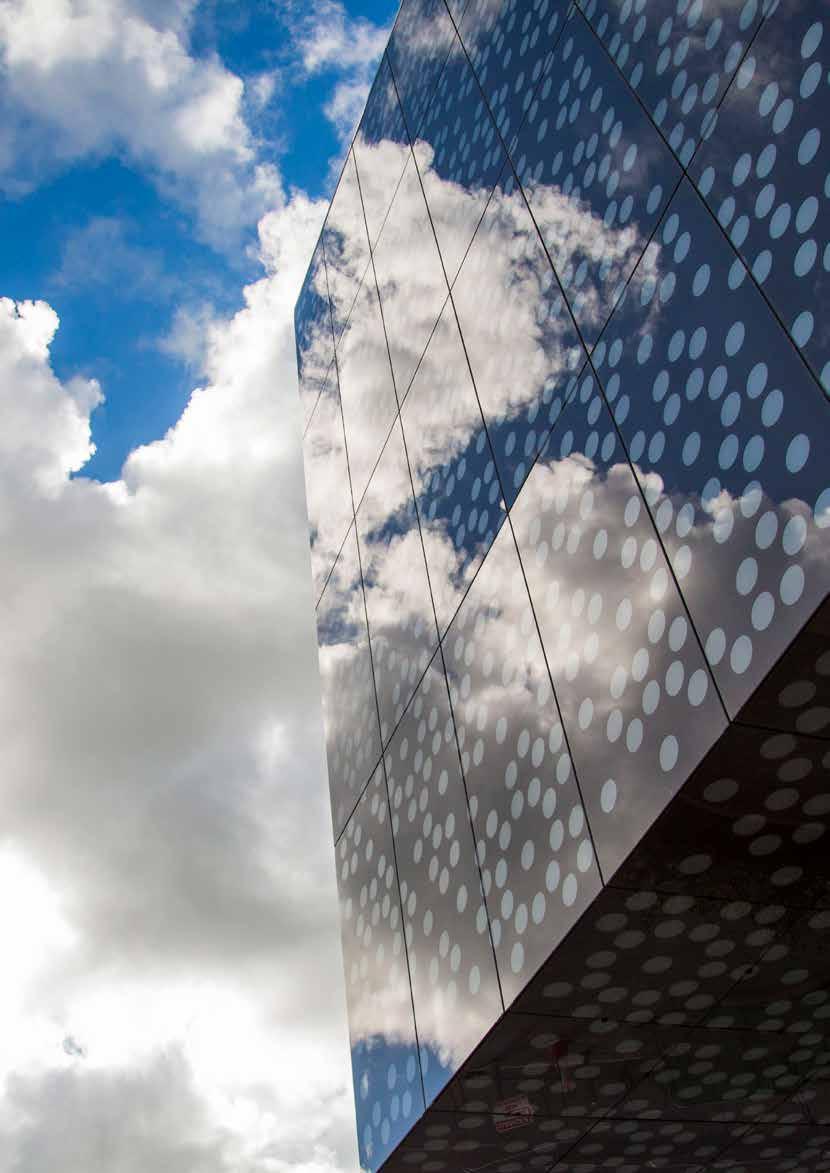
New generation 3D tumor models coupled with nanomedicine strategies provide solutions for cancer metastasis. Late diagnosis and chemotherapeutic resistance is a major obstacle to breast to brain cancer treatment which presents multiple challenges for optimal management of this deadly disease. A study by Dr Nanasaheb Thorat could lead the future in breast to brain cancer metastasis therapy. Dr Thorat’s research focuses on integrating engineering and technology with biology, from the laboratory scales to systems. Among other innovations, his group at Bernal has been developing various nanomedicines, 3D multicellular tumour models, light and magnetic field-activated point-of-care theranostics (therapy + diagnostics) devices for breast to brain cancer metastasis disease management.
Patients who have had chemotherapy know that as effective as it may be, it also causes damage to otherwise healthy cells. Dr Thorat’s research offers a localised targeted treatment for cancer metastasis that would avoid such damage. Ninety per cent of breast cancer (BC) patients die, not because of the primary breast tumour but due to tumour metastasis at a different site. According to the European Cancer Information System, approximately 950 new breast cancer patients are diagnosed and approximately 250 deaths are recorded every day. Among the total BC patients, 6% of women have metastatic breast cancer when first diagnosed.
Dr Thorat’s current research addresses breast to brain cancer metastasis disease management by using a targeted nanomedicine approach and profiling of metabolic mechanisms underlying breast cancer metastasis to brain. The objective is to predict the disease’s behaviour, develop novel therapeutic approaches and timely treatment responses. The SFI-IRC funded project, Plasmonic Nanomedicine Coupled Biomolecular Fingerprinting of Brain Cancer, ‘PHOTOBRAIN’, is
aimed at developing intra-cellular targeting plasmonic nanomedicines for brain cancer theranostics.
The project focuses on the magnetic and plasmonic nanoparticles functionalised with tumour-targeted anticancer molecules and drugs.
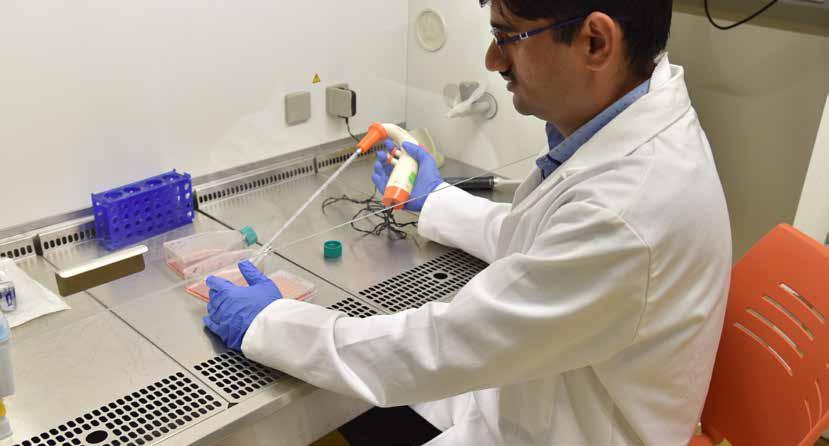
PHOTOBRAIN will use magnetically guided plasmonic nanomedicine of new-generation imaging for biomolecular fingerprint imaging. Bolstered by large-scale data analyses and 3D tumour models, PHOTOBRAIN will provide biomolecular fingerprinting of one of the most aggressive tumours, glioblastoma, that is long needed but so far unavailable, as a rational framework to investigate disease onset, progression and therapeutic interventions. Within the purview of such scientific premises, the impact of PHOTOBRAIN encompasses medium-term goals outlined in the Irish National Cancer Research Strategy (2017–2026). When successful, it would revolutionise the way that cancer diagnosis and therapy is carried out. Within the project, Bernal will commence a much deeper research project in the field of brain and breast cancer theranostics, with a particular focus on translation of the research output to patients. New research directions, alongside Dr Thorat’s long engagement with clinics in the field of minimally invasive devices, radiopacity and imagebased therapy delivery, ensures that the project’s outcome will create a very high medium- and longterm economic impact.
PHOTOBRAIN is providing training opportunities to young and enthusiastic researchers in the broad field of interdisciplinary cancer nanomedicine. The project’s milestones will achieve Ireland’s scientific priority on ‘Therapeutics’ and overcome identified weaknesses in and threats to current research.
Aleksandra Serafin has made great strides in her work on spinal cord injury, which remains one of the most debilitating, traumatic injuries a person can sustain during their lifetime, often affecting every aspect of one’s life. Spinal cord injury often results in the loss of motor and sensory functions, as well as paralysis at or below the injury site. In the United States alone, about 12,000 new cases of spinal cord injury are reported each year, with the annual healthcare costs for patient care amounting to $9.7 billion. As there is currently no widely available treatment, continuous research into this field is crucial to find a therapy to improve the patient’s quality of life, with the research field turning towards tissue engineering for novel treatment strategies.
Tissue engineering is an interdisciplinary field that merges such fields as engineering, biology and chemistry to provide regeneration strategies. It aims to solve the global shortage of organ and tissue donations. A recent trend in tissue engineering for spinal cord injury has emerged in the form of conductive materials. As many cells in the body are affected by electrical stimulation, spinal cord cells included, the addition of conductive elements can positively influence their growth and proliferation, and hence, even further aid the regenerative process.
Raising the conductivity of biomaterials to develop tissue engineering strategies typically centres on the addition of conductive components such as carbon nanotubes or conductive polymers such as the commercially available PEDOT:PSS. The major drawbacks of using these conductive additives arise from low conductivity in neutral pH, as well as insolubility in water. Poor biocompatibility has also been reported when examining the in-vivo degradation of the PEDOT:PSS polymer in particular, which relies on the toxic PSS component to allow for the polymer to be water soluble. To overcome these limitations, our team developed novel PEDOT nanoparticles (NPs). Synthesis of conductive PEDOT NPs allows for tailored modification of the NP surface to achieve desired cell responses. This also increases the variability with which hydrogel components can be incorporated, without the required presence of PSS for water solubility.
In our work, hybrid biomaterials comprising gelatin and immunomodulatory hyaluronic acid were combined with the developed novel PEDOT NPs to create biocompatible electroconductive scaffolds for targeted spinal cord injury repair. A complete study of the structure, property and functional relationships of these precisely designed scaffolds for optimised performance at the site of injury was carried out. Incorporation of PEDOT NPs into the biomaterial scaffold significantly increased the conductivity of the scaffolds to 8.3 × 10-4 ± 8.1 × 10-5 S/cm. The compressive modulus of the scaffold was tailored to match the native spinal cord at 1.2 ± 0.2 MPa in a biomimicry manner, along with controlled porosity. When testing for the biological performance of these conductive scaffolds, in-vitro studies with mesenchymal and neuronal stem cells showed that the scaffolds are cytocompatible. Further examination of the in-situ response with invivo assessments in rat SCI lesion models showed greater axonal cell migration towards the site of spinal cord injury, into which the PEDOT NP scaffold was implanted, as well as lower levels of scarring and inflammation than in the injury model, which had no scaffold. The implantation of the PEDOT NP scaffold allowed for a superior axonal migration and growth towards the targeted implantation site, through the provision of a stimulating microenvironment for regeneration. Overall, these novel conductive materials hold great promise for future neuronal tissue engineering applications.

Figure 3: Gel:HA:PEDOT-NPs 1× scaffold provided a diminished astrocyte, macrophage and microglia reactivity and inflammation, as well as increased axonal migration towards the lesion site, when compared to the lesion-only control. Representative immunofluorescence images of spinal cord tissue section labelling with A) NF200 (green-axons) and GFAP (red – reactive astrocytes) and B) IBA1 (red – microglia) and ED1 (green – macrophages), observed in the PEDOT 1× scaffold group and the lesion-only control group.

First place at this year’s Neuroscience Ireland Young Investigator Symposium was awarded to Bernal’s Janelle Stanton. Held at Trinity College Dublin, the symposium was attended by over 180 individuals from across Ireland, presenting their results through both oral and poster presentations. Janelle’s poster presentation envisaged the most recent findings in a collaborative study, ‘Patient-derived cellular models as tools to elucidate the pathophysiology of Hao-Fountain syndrome’. Collaborators from CHU de Nantes and Dr Andreas Grabrucker’s group have highlighted significant genes and pathways that are altered throughout neurodevelopment, by utilising iPS cells derived from PBMCs to further develop and differentiate them into neurons, and later on, cerebral organoids.

Marie Skłodowska-Curie Fellow, Dr Alison O’Connor, hopes to improve the efficiency of power plants by using machine learning and artificial intelligence. To reduce our carbon footprint, we must operate power plants at maximum efficiency, and extend the service life of critical material components simultaneously. Material component damage is complex and depends on three key factors: loading conditions, environmental conditions and specific material properties. The complexity happens when these key factors start to interact with one another; for example, the strength of steel and its mode of failure can change, depending on the test temperature. Similarly, the life of a component is reduced if it is in a corrosive environment such as seawater, compared to non-corrosive environments.
Currently, scientists and engineers analyse service life by assuming the worst-case scenario. Alison aims to use machine learning algorithms to assess how these complex multi-interactive factors inform the rate of damage in the material. The machine-learning algorithm can identify unknown parameter values more efficiently and accurately than humans.

The data generated from these tools can be used to ensure that structural integrity, and therefore safety, is maintained to the highest level, but will allow us to reduce our overall carbon footprint, thus directly contributing to a greener climate.
Lithium-ion (Li-ion) batteries are struggling to keep pace with advancements in consumer electronics and there are growing needs for alternative rechargeable batteries with significantly improved performance. Lithium-sulphur (Li-S) batteries stand out as one of the most promising ‘beyond Li-ion battery’ technologies, in terms of both cost and specific energy. Li-S batteries can deliver a practical gravimetric specific energy of ~600 Wh/kg, which is double the values offered by state-of-the-art Li-ion batteries. However, there are still issues that need to be addressed before widespread commercialisation of Li-S batteries can be made possible. These include the poor conductivity of sulphur and safety concerns over the use of pure Li metal as an anode.
The ALTERNATE project, comprising Dr David McNulty, Principal Investigator, and PhD student Deaglán Bowman, is funded through the SFI-IRC Pathway Programme. The project is investigating nanostructured, porous carbon materials (PCMs) as sulphur-hosting cathodes to increase electrical conductivity. Prelithiated silicon and germanium nanowires will be employed as innovative replacements for metallic Li. This highly novel pairing of electrodes will significantly advance state-of-the-
art for Li-S batteries, as the replacement of Li metal with alternative materials is an essential requirement for realisation of commercial Li-S batteries. Academic collaborations with researchers at Helmholtz-Zentrum Berlin (HZB) and the Paul Scherrer Institute (PSI), Switzerland, will enable in-situ/operando characterisation of battery electrodes in real time during charging and discharging. As performed at UL, a correlation of data collected from these characterisation techniques with long-term electrochemical testing, will shed new light on the charge storage mechanisms for Li-S batteries. The knowledge gained will be utilised to optimise battery performance in terms of voltage stability and capacity retention.

This project will enable Ireland to further establish its position as a leader in the research fields of nanostructure synthesis and energy storage, as Li-S batteries are an emerging energy storage technology for the future. The increased focus on energy storage research in Ireland will contribute to national objectives of becoming more reliant on renewable energy and decreasing fossil-fuel emissions, such as the ‘Transition to a Low Carbon Energy Future 2015–2030’ energy policy. The ALTERNATE project tackles issues outlined in the UN Sustainable Development Goals, specifically Goal 13: Climate Action. In terms of numbers, the global demand for energy storage is expected to rise exponentially over the next 30 years to thousands of terawatt hours and Li-S batteries offer a sustainable, low-cost solution to meet this demand.

A consortium led by Prof. Trevor Young has been awarded €0.91 million by the Sustainable Energy Authority of Ireland (SEAI) to conduct research into the mitigation of erosion damage to wind turbine blades. The 36-month project, which includes as partners: NUI Galway, SETU Carlow and TU Dublin, will contribute to meeting the objectives of the International Energy Agency’s Wind Task 46 on leading-edge erosion of turbine blades. Prof. Young was appointed to the IEA (International Energy Agency) Wind Task, with financial support from the SEAI.

Also in 2022, Prof. Young was elected Chairperson of the Scientific Advisory Body (SAB) to the Brusselsbased Clean Aviation Joint Undertaking (CAJU). The SAB constitutes international experts, who were selected following an open Call for Expression of Interest (CEI). The CAJU is a public–private partnership between the European Commission (EC) and the European aviation sector. Its goal is to accelerate the development of climateneutral aviation technologies for earliest possible deployment, establishing pathways to reach climate neutrality by 2050, consistent with the goals of the European Green Deal regarding greenhouse gas emissions. The CAJU manages the EC’s Clean Sky 2 and Clean Aviation research programmes, making it Europe’s foremost aeronautical research entity.
Dr Shalini Singh is developing high-performance nanomaterials from non-toxic, earth-abundant inorganics for photovoltaics, batteries and electrocatalytic reduction of CO2 She has adopted a bottom-up approach to synthesising ultra-thin nanomaterials composed of few atomic layers. Creating these atom-by-atom, using molecular precursors, provides vast opportunities to engineer their structure, dimensions and properties. By using different spectroscopic and microscopic techniques, Dr Singh’s team is now accruing a thorough understanding of the stoichiometry, crystal structure, morphology, opto-electronic properties and surface chemistry of synthesised nanomaterials and their potential as electrode materials for batteries or electrocatalysts. Dr Singh’s research is driven by her dedication to creating disruptive technologies to help achieve UN Sustainable Development Goal 7: Access to Affordable, Clean Energy, and Goal 13: Climate Action.


Dr Eric Dalton and Dr Valeria Nico of the Process Engineering Cluster have developed an ultrareliable magnetic shuttle pump (MSP), based on two counter-wound solenoid coils that are used to oscillate a neodymium shuttle magnet. Due to the ongoing miniaturisation and increased performance of electronics devices, alternative cooling methods are required, specifically mechanical pumping loops (MPL). In particular, since passive two-phase loops are not capable of cooling European Space Agency (ESA) expected power densities up to 300 W/m2, pumped two-phase loops are forecast to replace their passive counterparts. However, one of the main issues with the widespread use of such technology is pump reliability, as a pump failure directly results in cooling system failure. In addition to a reliability of over 20 years, the micropump is required to withstand working pressures greater than 60 bar and to be compatible with ammonia.
The team proposed to integrate an array of five MSP micropumps and a flow meter into a two-phase mechanical pumping loop for electronic cooling of space satellites. As part of the project, pressure tests up to 150 bar were carried out on the manifold of five pumps, in parallel and on the flow meter, to verify the capability of the devices to withstand the required high working pressures. The pressure was held for ten minutes and neither deformations nor leaks were observed.

Environmental tests were also carried out to determine the electromagnetic field and the microvibrations generated by the manifold, in order to verify the values as compatible with ESA requirements. Vibration tests on the manifold were


also carried out to verify that the unit could withstand the harsh environment associated with taking off and landing.
Reliability tests and corrosion tests in liquid ammonia were carried out. To date, the manifold has been running continuously for over 300 days, with no degradation detected. To identify corrosion, pump components were kept in a vessel for 117 days, 40% filled with liquid ammonia, and no corrosion or discoloration was detected.
Finally, the manifold and the flow meter were integrated into a flow control unit for a two-phase MPL system, using Novec 7100 as working fluid. Three different tests were carried out, considering: different values of input power to the manifold, different numbers of working pumps, and different thermal bath temperature with three working pumps. It was demonstrated that the manifold could dissipate up to 320W at 1.5W input electric power.
The work was presented at the 28th International Workshop on Thermal Investigations of ICs and Systems (THERMINIC), held in Dublin in September 2022. Dr Nico was also recently a guest on the podcast, ‘Power and Responsibility – The Data Centres Podcast’, where she talked about her work with ESA and how two-phase cooling could be also implemented in data centres. In addition, Dr Dalton and Dr Nico travelled to the European Space Research and Technology Centre (ESTEC) to test the microvibrations generated by the manifold.
Research by Dr Vanessa Egan aims to develop thermal management solutions for 5G and future networks. The development of these networks will offer faster download speeds, more capacity and much higher connectivity, which will transform the technology used for virtual reality, the internet of things and artificial intelligence. One of the main challenges is maintaining operating temperatures at acceptable levels. These networks require a lot of physical base stations that contain densely packed electronic components dissipating large amounts of heat.
Dr Egan’s research has focused on the design of passive, two-phase heat transfer devices to provide cooling for these electronic components. The main findings from her research include design criteria for multiple component cooling and the development of a novel diagnostic tool that can underpin the optimisation of device manufacture.

Science Foundation Ireland funds Dr Egan’s research under the CONNECT Research Centre.


 Dr Vanessa Egan, Process Engineering Cluster
Dr Vanessa Egan, Process Engineering Cluster
Research led by Dr Ronan Courtney is investigating valourisation and reuse options for restoration and rehabilitation of legacy waste sites and improving ecosystem services in restored industrial lands. Moving society towards clean energy will require significant increases in the demand for raw materials and production of associated waste and residues, in order to avoid irreversible environmental damage. Currently, the disposal/management of these wastes occupies a land footprint of some 2,000 square kilometres, which can present risks to the environment, and challenges the sustainability of resource supply. Through characterisation and assessment of different waste streams, inhibitory and restrictive properties can be overcome, beneficial characteristics identified, and reuse options found. The research team at UL has pioneered techniques for creating engineered soils from waste materials and using natural systems for resource recovery.

The societal, environmental and economic impacts of this research include: (1) mitigation of pollution risks, (2) restoration of degraded areas, leading to enhancement of surrounding ecosystems, (3) increased implementation of biodiversity, (4) biological carbon sequestration, (5) improved sustainability of resource supply and (6) circular economy implementation at source.
This study is funded by a number of sources including: Science Foundation Ireland, the Environmental Protection Agency, Enterprise Ireland, the Irish Research Council, and associated industries.

Dr Chiara DeBenedictis seeks to assess metal exposure, bioavailability, potential transfer and toxicity for key metal contaminants (As, Cd, Cr, Hg, Pb and Zn) in exposed earthworms. The rehabilitation of industrial residue sites and mine tailings in Ireland represents an important environmental challenge. The development of a healthy ecosystem is reliant on multiple waste management strategies. Earthworm populations are recognised bioindicators of soil quality and health and can be used to identify specific biomarkers that correlate with metal exposure and toxicity.
Dr DeBenedictis is creating a database of ecotoxicological studies carried out with earthworms to assess the potential toxicity of metals associated with Pb/Zn mining. She will make an in-vitro metals toxicity model, using 2D (cell lines) and 3D (intestinal organoids derived from stem cells) to mimic critical threshold values of metal concentrations and their toxic effects. The results generated will provide indepth knowledge of soil pollution at industrial residue sites and mine tailings in Ireland.
Marie Marie Skłodowska-Curie Fellow, Dr Joseph Mooney, is exploiting novel porous materials that can convert sea water to fresh water, using solar energy. According to the World Wildlife Fund, twothirds of the world’s population may face water shortages by 2025. Water desalination technologies are promising solutions to the global water scarcity crisis.
Solar desalination represents one of the most favourable low-cost, green and sustainable solutions to the pressing global challenges of clean-water shortages and is vital for off-grid and remote island regions at risk of severe drought. Dr Mooney’s project, SEAFRONT, aims to produce a deployable and highly efficient passive device, through an investigation into the thermo-fluidic behaviour of hydrogels. Hydrogels can absorb water and enable high solar-to-vapour conversion efficiencies, while also providing anti-fouling properties. Studies on these state-of-the-art hydrogel materials are suggesting that further analysis into their underlying physics is essential for future developments.
Bernal’s Process Engineering cluster, led by Prof. Gavin Walker, is considered one of the leading Artificial Intelligence (AI) research clusters in Ireland and Europe, with a sheer volume of industrial cooperation and scientific publications recognising the quality of its research.

For those like researcher Qatada Damra, working in fields related to AI, 2022 was undoubtedly found to be an exceptionally interesting time. There has been a huge surge of excitement and hype surrounding AI, with breakthroughs in machine learning, natural language processing and robotics making headlines on a regular basis. According to Prof. Walker: ‘By incorporating AI and machine-learning algorithms into process control, the cluster aims to optimise manufacturing processes to make them faster, cheaper and more environmentally sustainable.’
That being said, there is more to Prof. Walker’s team than scientific advancement or industrialisation of research outcomes. Community engagement is the third pillar of its values. ‘In Bernal’s Process Engineering cluster, we emphasise that community engagement goes beyond environmental impact, publishing papers and industrial collaboration. We stress the importance of our community in research; we acknowledge that they know their problems inside out, and thus they can direct/inform our research.’
“Although water scarcity is considered a genderless crisis that could affect the entire human race, women and girls around the globe spend an estimated 200 million hours hauling water every day.”
One of the cluster’s flagship projects is the ‘AI for School Initiatives’. This project, a cross-border collaboration between secondary school teachers in Jordan and Ireland and funded by the CONFIRM Education and Public Engagement (EPE) programme, aims to empower teachers to integrate AI concepts into their classrooms. The project works to co-create low-code/no-code AI-focused resources for use in the classroom.
This project is an example of Community Engaged Research. ‘We collaborated with AI professionals and researchers to identify the most beneficial AI tools for the future workforce. We built a knowledge pool of these tools and then introduced them to teachers. Together, we co-created lesson plans and tools to communicate these technical concepts effectively to students. Collaborating with teachers guarantees that young students will have a thorough understanding of the concepts, while also providing them with an enjoyable learning experience. Moreover, it empowers teachers to have full control over the delivery and integration of AI resources in their classrooms.’
With this focus on education and innovation, Ireland is well positioned to continue its rich history of technological advancement and contribute to the global AI revolution. The country’s strong academic institutions, talented workforce and supportive business environment make it an ideal location for companies and researchers to develop and deploy cutting-edge AI technologies. As AI continues to reshape industries and transform the way we live and work, Ireland is sure to play a vital role in shaping the future of this exciting field.

SeAFEED is a cross-border study that commenced in 2022, with the aim of finding natural bioactive compounds from sustainable marine resources to replace zinc in pig feed. The study received €1.2 million in funding, as part of a jointly funded programme by the Department of Agriculture, Food and Marine (DAFM) and Department of Agriculture, Environment and Rural Affairs (DAERA), to address the effects of the recent EU ban on zinc oxide in pig feed. In Ireland, the pig industry is the third largest livestock sector after beef and dairy. This collaborative study, between the Bernal Institute and the School of Mechanical Engineering at Queen’s Marine Laboratory in Portaferry, the School of Chemistry and Chemical Engineering at Queens University Belfast, and Health and Nutritional Sciences at the Atlantic Technological University Sligo, will investigate the use of seaweed extracts as an alternative to zinc oxide, which was used as a therapeutic additive in piglet diets to combat diarrhoea and reduce animal disease.
Prof. Gavin Walker, who is leading the project, explains: ‘The project will examine the overall value chain from naturally enhancing the bioactive compounds at the growth stage of the seaweed, to greener and more environmentally friendly drying methods for seaweed biomass and separation methods to produce enriched fraction from seaweeds with antimicrobial properties, that can be added as a feed ingredient. It will also explore the environmental impact of using seaweeds in the animal feed industry and the green credentials of the drying and separation processes, which will lead to the development of a more sustainable and all-island circular economy.’
In 2022, then Tánaiste Leo Varadkar established the Shannon Estuary Economic Taskforce (SEETF), comprising business, policy and academic leaders of the region, of which Bernal Director, Luuk van der Wielen, is also a member.
SEETF had its launch meeting at UL on 6 May 2022, circulating further meetings around the Estuary. The Shannon Estuary region at the Mid-West Atlantic Coast of Ireland presents one of the premier European opportunities for developing a large-scale floating offshore wind energy hub. This is due to (1) the natural geography of a sheltered deep water port at close proximity to the Atlantic Wind Potential, that allows for a full manufacturing, assembly, monitoring, maintenance and repair and end-of-life/circular materials industry, (2) the starting point of a flexible onshore industrial and societal demand through modernising and greening the power industry of ESB’s MoneyPoint facility, converting proactively into the requirements of (dynamic) renewable power by implementing a synchronous compensator and battery technology for grid stabilisation and integrated plans for hydrogen manufacturing and use (MoneyPoint Green Atlantic), (3) an opportunity to further futureproof the existing commodity (cement, aluminium) and high added-value industries (pharma, medtech and microelectronics), especially in decarbonisation, with direct positive impacts on the regional environment.
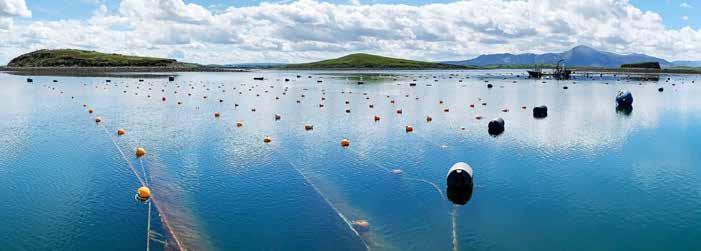
The combined plans of SEETF have been fully embraced by the Irish Government through public statements from the Department of Enterprise, Trade and Employment, as well as Shannon Scheme 2.0, mentioned as a key pillar (Fourth Ambition) of the Irish Government in December 2022.
The Masterplan of Shannon Foynes Port Company (SFPC), with clear inputs from the Bernal Institute on materials circularity and innovation, recognises three consecutive phases of 10 GW each, towards 30 GW installed nominal capacity in 2050. The initial phase towards 2030 must be used explicitly to accelerate Irish industrial and academic learning, ideally in international co-development with leading industrial and academic partners from Denmark, Norway, The Netherlands, United Kingdom and others. Through the Bernal Institute, UL has positioned itself strategically with key Irish and European partners, in first co-development projects, especially on combined (hybrid) model-based (digital twin) and realistic data collection.
Most short–medium term FLOW (Floating Offshore Wind) developments are obviously based on international technology and building blocks, due to the limited historic offshore energy and onshore industrial tradition in Ireland. As SEETF has shown, this leads to a significant fraction of the required direct investments to be spent internationally, with

only an estimated 35–38% of the Direct Investments in the Irish economy. This results in a modest combined direct, indirect and induced economic effect that will not fully capture the potential economic effect.
SEETF foresees, however, that competitive Research, Development and Innovation (RD&I) programmes can yield commercial technology in elements of the FLOW supply chain and solutions to onshore flexible industrial demand. This provides opportunities for increasing the 35% of direct investments in Ireland towards 50%, and thereby a much larger economic effect. Again, structured materials research, as at Bernal, supporting turbine innovation, energy storage and conversion and further industrial use, are instrumental to capturing these opportunities.
Obviously, this requires an estimated development time of approximately a decade. The bulk (80%+) of the required offshore and onshore capital investments are expected after 2035. That gives Ireland a minimum of 12 years development time, while learning from launching its commercial projects at scale such as Moneypoint/Green Atlantic Floating Offshore Wind farms, to achieve the planned onshore hydrogen and other green manufacturing capacity that will effectively function as a test bed and demonstrators.
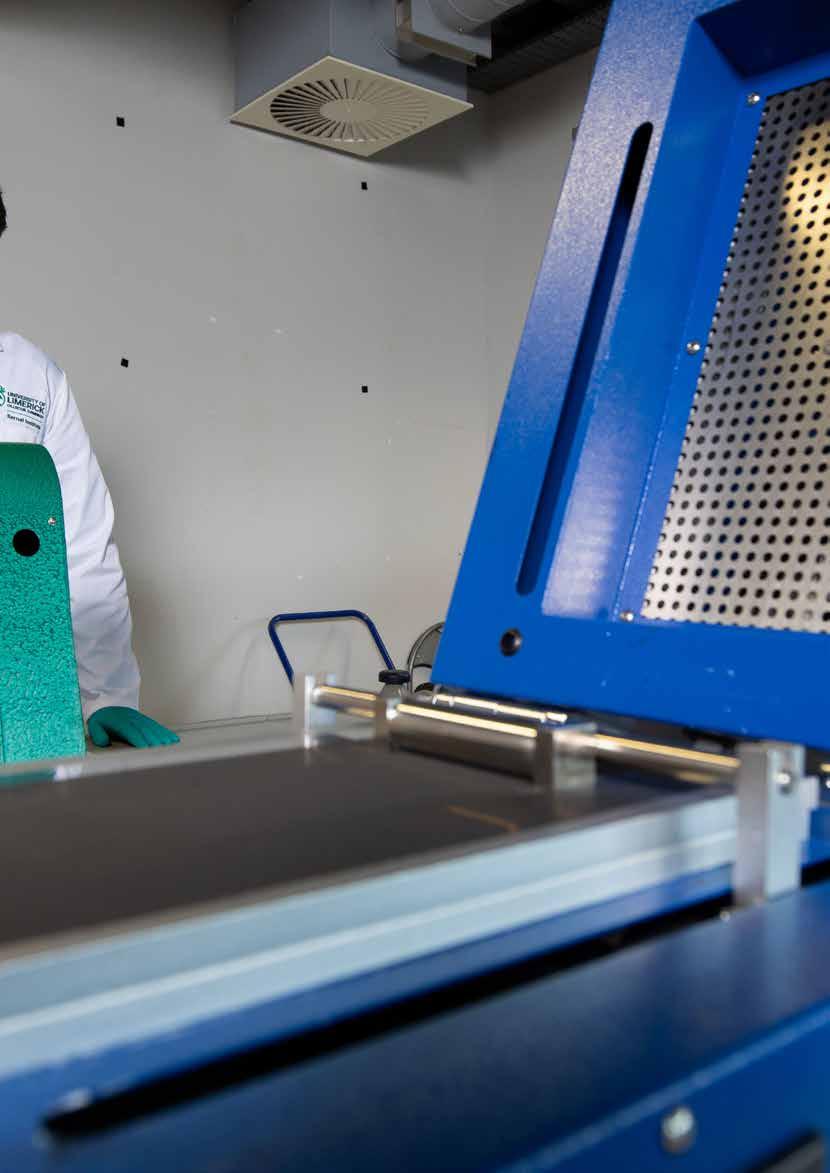
In the Shannon Estuary Masterplan, RD&I zones have already been identified, often co-siting with industrial roll-out. Especially included are wind-turbine blade innovation manufacturing, maintenance and refurbishment and end-of-life circularity (Cahiricon village), substructure manufacturing (MoneyPoint), platform assembly (Foynes Island), transport through the estuary (region Kilrush), onshore flexible demand integration for eFuel and sustainable materials manufacturing (MoneyPoint and TarbertBallylongford) to complement offshore windfarm locations.

SEETF will deliver its final report in mid-2023, describing an exciting journey for the Shannon Estuary region, Ireland and Europe. At the time of writing, also in mid-2023, the Bernal Institute, with its regional, Irish and especially international codevelopment partners, is well prepared to embark on such a journey. Many of our recent and current scientific breakthroughs and engineering solutions can contribute to, and benefit from, these important developments, both within and out of the Shannon Estuary region. This will not happen automatically and we need to develop and drive proactive initiatives, starting in 2023. We have a healthy pipeline of ideas and graduates that we will increasingly stimulate towards the entrepreneurship that is required to fully capture this potential, in the Spirit of Shannon Scheme 2.0.

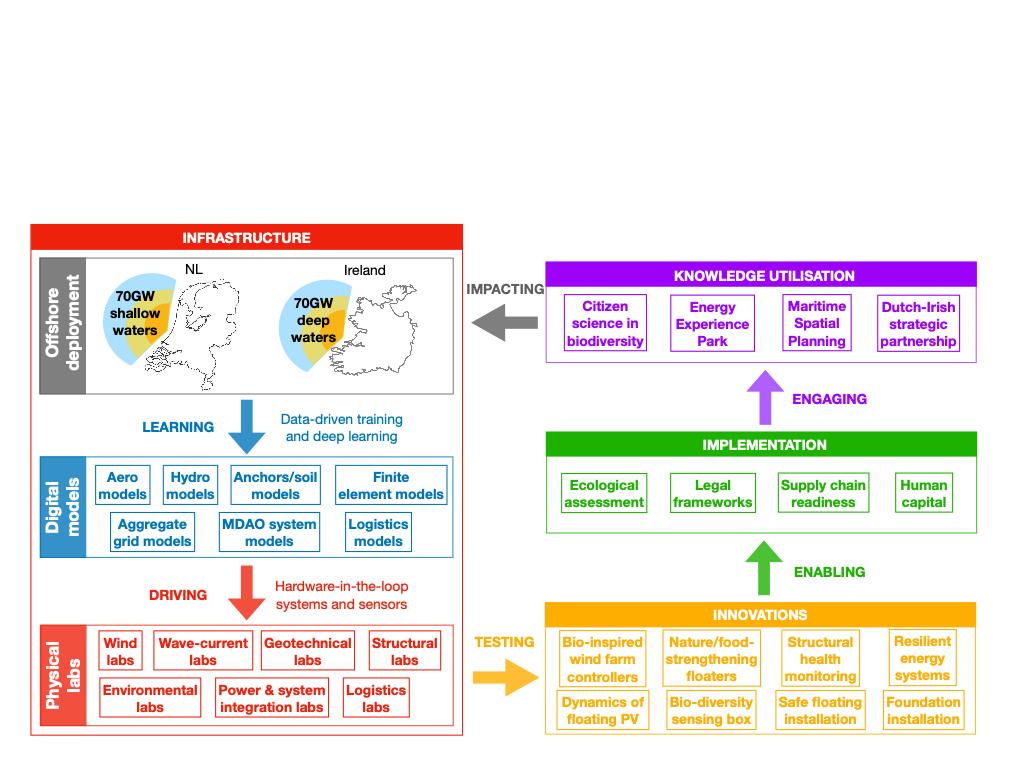

Predictive computational modelling underpins our research at Bernal by accelerating the design, engineering and integration of structured materials required for health, energy and environment applications. The fundamental blueprints and design rules our modellers generate are helping us to tackle grand challenges in biopharma, composites and power generation. Using high-performance
computing, our modellers develop and apply modelling tools, from omics to molecular models and computational fluid dynamics to analytical models, integrating AI and machine learning, where appropriate, to deliver fast, robust design solutions. The following are the recent highlights from our Bernal Researchers in modelling for 2022.

Chemicals and materials touch the lives of everyone every day and are crucial for enhancing quality of life. Production (and safe disposal) of most of these involve the use of multiphase reactions and reactors. Prof. Vivek Ranade and his Multiphase Reactors and Process Intensification group at Bernal use experiments, computational flow modelling, reactor engineering and machine learning to generate new insights in multiphase flows, multiphase reactors and process intensification. The goal is to use data, computational models (physics, as well as data driven) and innovative fluidic devices for developing MAGIC (modular, agile, intensified and continuous) reactors and processes and ‘factory in a box’ platforms to enable decentralised manufacturing, tailored products, responsible resource usage and decarbonisation, as well as mitigation and valourisation of waste.
Prof. Ranade is developing vortex-based cavitation devices and fluidic oscillators in order to intensify a wide range of multiphase processes, including crystallisation, emulsions and reactions.
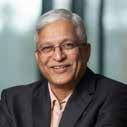
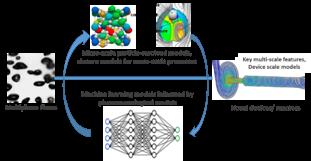

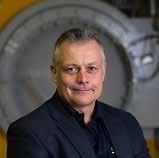
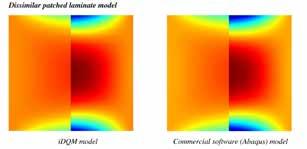
Dr Saheed Ojo creates increased design flexibilities to improve the response of mechanical structures to meet a wide range of applications, utilising stiffness tailoring offered by variable stiffness (VS). The increased design space created by VS techniques leads to complexities of non-classical phenomena that necessitate robust computational frameworks with enriched kinematics, to predict the structural response under varieties of load, boundary and material configurations. As a demonstration, the bending behaviour of dissimilar patched laminates comprising the assembly of symmetric and non-symmetric composite layup was accurately predicted with our in-house iDQM tool, which guarantees up to 95% computational savings, compared to Abaqus commercial software.




Over recent decades, morphing structures have been increasingly considered in many different engineering fields, due to their potential be lightweight, load-bearing, self-actuating and multifunctional. Furthermore, can substantially reduce cost and actuation power requirements, making them appealing for a large variety of engineering applications.
Giovanni Zucco and Prof. Weaver presented a new of multi-stable corrugated shell structure on elastic They name this structure ‘corrugated popping dome’. Multi-stability is used to achieve complex shape reconfigurations and to structures that can be quickly deployed in a wide of mechanical and aerospace engineering applications.
Dr Saheed Ojo, Composites Cluster Prof. Paul Weaver, Composites Cluster Dr Giovanni Zucco, Composites Cluster

Antibody therapy is a proven treatment for many chronic diseases, including cancer, but it typically requires injections. Bernal scientists are working on ways to make it possible to take these drugs orally, which would be much easier for patients. One promising method is to use protein carriers called ‘block copolyelectrolytes’ (BCPEs) that can protect the drug from damage and release it in the right part of the body. In a recent study, Dr Sousa Javan Nikkhah conducted mesoscale, coarse-grained simulations to design novel platforms that can protect Trastuzumab (Herceptin®), an antibody used to treat breast cancer, in the harsh environment of the stomach and then release it in the intestine. The simulations showed that the BCPEs self-assemble into a stable structure that can protect the drug at low pH and then release it when the pH is closer to neutral. These findings help scientists to develop new oral treatments for cancer and other chronic diseases that are currently treated with injections.


Prof. Daniel Granato works with functional foods and ingredients. He uses response surface methodology to optimise the extraction of bioactive compounds from plant-based origins and maximise their healthpromoting properties, using 2D and 3D response plots coupled with multivariate regression modelling. Prof. Granato is developing artificial neural networks and random forest modelling to authenticate the origin of food products, using different analytical approaches.

Peptide-based supramolecular materials have attracted growing attention due to their bio-inspired nature, ease of large-scale synthesis and useful biodegradability. The carnosine (β-alanyl-l-histidine) dipeptide, studied in this work by Dr Sarah Guerin, is an endogenous antioxidant found in the heart, skeletal muscle fibres and brain. Carnosine has been shown to inhibit the oligomerisation of Aβ-amyloid in rat brain endothelial cells, which may be due to its capability to form salt bridges with charged side chains and van der Waals contacts with core hydrophobic residues. Here, modelling predictions of the large, guest-specific response of carnosine-zinc peptide-MOFs, assembled with five different guest molecules, guided creation of the robust power-generating molecular material. The findings demonstrate that the regulation of host–guest interactions could serve as an efficient method for engineering sustainable peptide-based power generators.


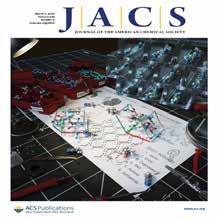
Dr Shayon Bhattacharya develops and deploys computer-assisted molecular models and tools to investigate diverse mechanisms behind progression of pathological protein aggregation in incurable neurodegenerative diseases (NDs), such as Alzheimer’s and Parkinson’s. These nanoscale models are developed at different stages of the protein self-assembly pathway, including their interactions with metal ions, and on biological membranes and functionalised surfaces to exploit new therapeutic targets and rationally design drug treatments for neurodegeneration. In addition, the design rules derived from re-engineering biomolecular complexes are deployed for drug development to treat chronic diseases such as different kinds of cancers. Extensive modelling-led investigations and design of potential therapeutics are performed, using high-performance computing facilities, at the Irish Centre for High-End Computing (ICHEC). These guide further experimental evaluation of biological
problems, in collaboration with leading academic and industry partners across the world and within Europe. The core of theory and computation used in molecular modelling at the nanoscale is formed from advanced modelling techniques such as high-throughput screening of proteomic data. Together they work with macromolecular docking and traditional and enhanced sampling molecular dynamics simulations, to compute properties such as binding free energies, contact maps and cross-correlation network maps.
 Dr Sarah Guerin’s work featured on the cover of the Journal of the American Chemical Society
Dr Shayon Bhattacharya Molecular and Nano Cluster
Dr Sarah Guerin’s work featured on the cover of the Journal of the American Chemical Society
Dr Shayon Bhattacharya Molecular and Nano Cluster


The cleaning of process equipment is essential for pharmaceutical production processes to prevent contamination. Cleaning processes must be effective, while also minimising cleaning times and resource usage. Dr Orest Shardt models solvent flows to quantify cleaning rates and the effects of key parameters in the Pharmaceutical Manufacturing Technology Centre (PMTC). In the PMTC core-funded project, SPOTLESS, a 3D-printed experimental rig was used to study the morphology of the film and the rate of cleaning from sample surfaces with deposits of representative compounds. Postdoctoral researcher, Dr Mohsen Hassanzadeh Moghimi, implemented a model of multiphase flow and solute dissolution in the ANSYS FLUENT commercial software for computational fluid dynamics (CFD) simulations. To validate the robustness of the model, the simulations are compared with observations from experiments. Figure 15 shows a
sample simulation, in which the liquid (red) flow rate is low and a rivulet forms instead of a film. At higher flow rates, the solvent forms a film that covers the whole surface (blue). These simulations were performed using the supercomputer at the ICHEC

Dr Mehakpreet Singh develops predictive empirical and mechanistic tools for the wet twin screw granulator (TSG), using hybrid artificial intelligence and a population balance approach. The models are based on the population balance model (PBM) for prediction of particle-size distribution, while artificial neural network (ANN) was used for estimation of mean residence time, which is required for numerical solution of the PBM. The model considers liquid and feed flow rates and screw speed, while the granule size distribution is the main output. The mathematical model accounts for aggregation and breakage of the particles occurring in five compartments of the TSG with inhomogeneous screw configurations (three conveying zones and two kneading zones). Aggregation and breakage were considered the main mechanisms in the process, and the model was developed and solved for the different conveying and kneading zones of the extruder. The model’s
predictions were validated through comparison with experimental data collected using a 12mm twin-screw extruder for granulation of microcrystalline cellulose. The results indicated that the model is facile, robust and valid, which can predict the performance of the twin-screw granulator for pharmaceutical formulations. The developed model enables the pharmaceutical industry to optimise their process more efficiently than the existing approaches.



The structure–activity relationship is a cornerstone topic in catalysis, which lays the foundation for the design and functionalisation of catalytic materials. Dr Matthias Vandichel models the electrocatalytic hydrogen reduction (HR) and hydrogen evolution reaction (HER) by palladium (Pd), as it can play a significant role in realising a sustainable chemical industry. The structure–activity relations that govern the electrochemical HER on Pd(hkl) electrodes are elucidated using first-principles density functional theory (DFT) calculations, which reveal an activity trend following Pd(111) > Pd(110) > Pd(100). Furthermore, it could be proven that the formation of subsurface hydride layers causes morphological changes and strain, which increase the hydrogen evolution activity. The obtained results are indispensable for the general understanding of metal hydride systems and formulation of design principles for the optimal Pdbased nanostructured catalysts.
A breakthrough discovery opens the door to unconventional, brain-like computing at the tiniest scale of atoms and molecules. Prof. Damien Thompson worked with an international team of scientists to create a new type of multifunctional switch that learns from its past behaviour. Their two-nanometre thick layer of molecules, which is 50,000 times thinner than a strand of hair, remembers its history as electrons pass through it. The switching probability and the values of the on/off states continually change in their molecular material. This provides a disruptive new alternative to conventional siliconbased digital switches that can only be either on or off. The study was led by Damien Thompson, Professor of Molecular Modelling and Director of SSPC, the Bernal-hosted Science Foundation Ireland national research centre for pharmaceuticals, together with Christian Nijhuis at the Center for Molecules and Brain-Inspired

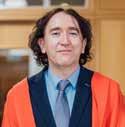
the University of Central Florida. Their newly discovered dynamic organic switch displays all the Boolean logic functions necessary for deep learning, successfully emulating Pavlovian ‘call and response’ synaptic brainlike behaviour during proton-coupled electron transfer reactions.
The researchers demonstrated the new materials properties, using extensive experimental characterisation and electrical measurements, supported by multiscale modelling, spanning from predictive modelling of the molecular structures at the quantum level to analytical mathematical modelling of the electrical data. This breakthrough opens a whole new range of adaptive and reconfigurable systems, creating new opportunities in sustainable and green chemistry, from more efficient flow chemistry production of drug products and other valueadded chemicals to development of new organic materials for high-density computing and memory storage in big data centres.

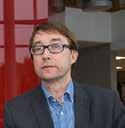


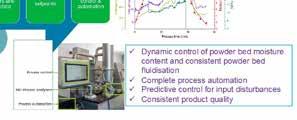
Prof. Gavin Walker, Dr Patrick Cronin and Dr Samuel Solomon are developing and incorporating mechanistic models into a commercial SmartX process modelling platform, developed by Innopharma Labs (Ireland) and Glatt (Germany) to provide in-process insight for Fluidised Bed Granulation (FBG) without physical Design of Experiments There is currently a lack knowledge or commercial incorporates data process tools or software that can information obtained from analytical technology (PAT) FBG. These tools enable process monitoring, pre-/post-process insights and continued improvement in product quality, with regulatory requirements for pharma, and food sectors for process FBG. We have developed macroscale mechanistic utilise information obtained (particle size, moisture content, composition) during FBG automate and control FBG critical in-process constraints
These models have been integrated into the commercial SmartX platform and will consider changes in ambient conditions through specialised sensors that may otherwise act as process disturbances.

Prof. Noel O’Dowd uses modelling and testing methodologies to find the best materials for engineering applications such as power generation and aerospace. This research initiative will provide an understanding of how materials fail and how to predict and prevent such failures. The findings could make energy generation safer and more efficient, with reduced environmental impact. The study, which is funded through Science Foundation Ireland (SFI), involves partnerships with the ESB and Wood Ireland and partners outside of Ireland. Prof. O’Dowd’s expertise lies in the development of material models and predicting service behaviour of materials, using finite-element analysis as shown in Figure 19.

Figure 19: Modelling of the micropillar compression test (a) focused ion beam image of the selected grain, (b) inverse pole figure map of the grain, (c) micropillar after deformation, (d) Experimental stress–strain curve, (e) finite element model of the micropillar compression test, (f) contour plot of the equivalent plastic strain obtained from the finite element simulation and (g) numerical stress-strain curve. Image credit: Samaneh Isavand, Pavan Rao

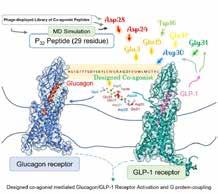

In the predictive materials modelling group led by Prof. Damien Thompson, Shubham Vishnoi has been designing peptide-based therapeutics to address metabolic disorders such as diabetes/ obesity and cancers. Peptide therapeutics offer improved efficacy and fewer side effects over small molecules. Small molecule-based drugs currently make 90% of the approved medicines in the market. goal is to design potent, pharmacologically peptides that can manage metabolic disorders, providing superior glycaemic and weight-loss control. Given the possible therapeutic effects of modulating the Class B1 G protein-coupling receptor (GPCR) signalling pathway in diabetes and obesity, along with other associated metabolic disorders, the primary objective of Shubham’s research work is to design and optimise peptide agonists using supercomputing-facilitated, based molecular dynamics simulation techniques. This work is part of an ongoing collaboration SSPC industry partner, Merck New Jersey, development of co-agonist peptide therapeutics.



In 2022, almost €4.3 million was awarded to four researchers from the Bernal Institute through the programme announced by Simon Harris TD, Minister for Further and Higher Education, Research, Innovation and Science. The funding will go to the creation of facilities or purchase of equipment, which are vital for the advancement of research currently underway. The investments have a strong focus on sustainability, with funding to establish a national rechargeable battery fabrication and test facility, sustainable composites, nanopharmaceuticals and electron microscopy.
The four projects to receive the funding were awarded to Prof. Kevin M. Ryan, Prof. Ursel Bangert, Prof. Maurice Collins and Dr Luis Padrela. Welcoming the announcement, Professor Norelee Kennedy, Vice President Research at UL said: ‘This is a significant success for the awardees and for UL, recognising the cutting-edge research being undertaken at the university to support a sustainable society – the investment supports UL’s strengths in materials research hosted at the Bernal Institute that addresses global challenges in energy, environment
and health. The infrastructure funded, supporting areas of strength in battery research, pharmaceutical processing, sustainable materials and electron microscopy, will underpin further advancements in these fields.’
Announcing the award, Minister Harris stated: ‘The research community on our island has consistently proved itself to be world-class and continues to undertake cutting-edge, innovative research projects. In order for this community to continue to thrive, it’s essential that they have sustained access to modern infrastructure and equipment.’
Commenting on the investment, Prof. Philip Nolan, Director General, Science Foundation Ireland said: ‘Encouraging and supporting excellent, ambitious and innovative research projects is the core objective of Science Foundation Ireland. The SFI Research Infrastructure Programme was developed with this in mind; in order for researchers to continue to deliver outstanding research and meet evolving and future challenges, we must ensure that they have the tools required for their research.’
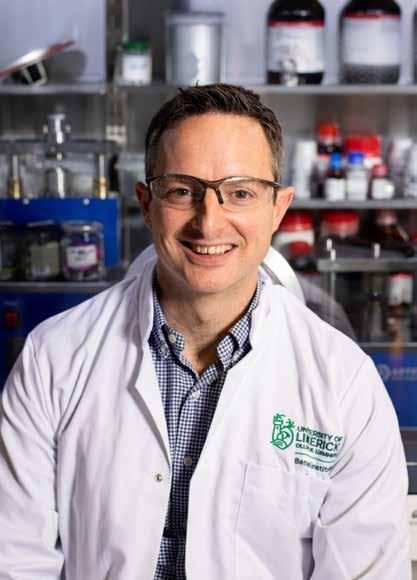
Molecular and Nano Cluster
Co-funded by SEAI, this new facility is the first of its kind in Europe. It identifies a significant gap in national resources and will give leading capability in battery research that is competitive at international level. It will allow for state-of-theart characterisation of novel battery materials with unprecedented detail, allowing better batteries to be developed for a range of applications and will be a one-stop-shop for battery development, not present anywhere else in Europe.
It will combine electrode fabrication, cell assembly, testing and state-of-the-art materials characterisation within one location for the first time within Ireland.

Molecular and Nano Cluster
A transmission electron microscope (TEM) can characterise the structure of materials, not only under stationary conditions and in-vacuum, but also under external stimulus and environmental conditions. In this way one can observe, for example, formation and growth of material phases and also structural changes, e.g. during heating or electrical biasing.
These studies can be performed at high (near atomic-scale) resolutions and will significantly enhance and complement existing TEM facilities at the Bernal Institute. The infrastructure will therefore enable much more detailed, realistic studies of the properties of materials than was possible so far, enabling more fundamental discoveries of their properties and empowering applications of these materials in novel appliances and devices and in their design.

Nanopharmaceuticals have the potential to overcome the current barriers that life-saving medicines are facing in order to reach the market. However, drug development and launching of novel medicines containing nanomaterials are being hampered world-wide by limitations in the ability to develop robust and scalable compliant methods of production that enable progression from a small production scale (in the mg range) to a commercially relevant scale (in the kg range).
The purpose of this infrastructure is to provide a unique state-of-the-art test bed with new ‘smart’ process systems, which will allow researchers and scientists in the field to de-risk the scalability and manufacture of nano(bio)pharmaceuticals and facilitate the adaptation of these technologies to existing industrial facilities. Critically, this capability is not currently available in Ireland.
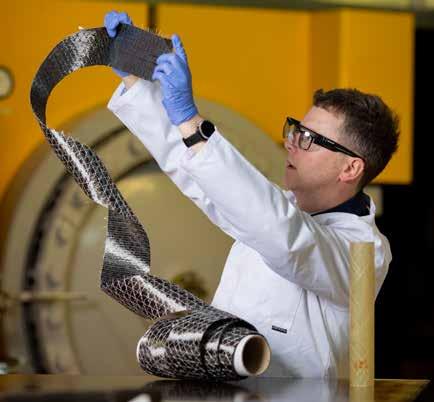
ScoPe addresses the challenge of developing efficient and sustainable composite materials to meet the global sustainability demands of an increasing population. It aims to develop a frontier composite materials processing and characterisation suite for the production of nextgeneration, high-performance composite materials to support the engineering industry in Ireland across sectors such as renewable energy harvesting and storage, transport (including agri-machinery), construction and medical devices.
There is a growing global awareness around sustainability of materials, greenhouse emissions and climate change, while in parallel, fossil reserves are dwindling. This has brought the production of new materials in more efficient ways from sustainable sources into sharp focus.
ScoPe aims to avoid waste accumulation and to promote the circular use of resources via the valourisation of bioresources through sustainable biocomposite materials. This is of crucial importance for future sustainable development.
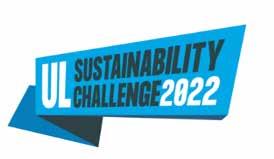

For fifty years, UL has been at the forefront of finding solutions to today’s challenges. The UL Sustainability Challenge is a competition for UL students to develop proposals to tackle our climate crisis. The aims of the competition are to support the university’s commitment to sustainability; to inspire, stimulate, facilitate and action students’ thoughts around sustainable development; and to offer a platform for our students to action research ideas, concepts and ambitions. The competition is a partnership between the Bernal Institute, Faculty of Science and Engineering (S&E), Kemmy Business School (KBS), Buildings and Estates Department (B&E) and Office of Vice President Research (RO). It calls on students to submit ideas to make our environment more sustainable – to either the campus, the city and/ or the wider Mid-West region, or further afield.
In November 2022, five finalists were selected by an independent expert panel. The Student Challenge was divided into three phases and launched during Research Week 2022. First phase included formulating team or individual ideas, followed by applications during the summer (second phase), after which, teams were invited to pitch their project proposal to the Independent Expert Jury (third phase). The
jury then selected the five most promising project proposals. These teams or individuals each received up to €10,000, along with development support, to prepare and deliver a working pilot or demonstration of their proposal by March 2023.
Finalists were supported by appropriate UL units and partners to deliver a working pilot or demonstration of their ideas. The overall outcome was evaluated against targets, feasibility and plan by the Independent Expert Jury in April 2023. The winning team was announced the same afternoon during Research Week 2023. Finalist teams, their families and friends were invited to the official announcement of the UL Sustainability Challenge Winning Team by UL President, Prof. Kerstin Mey, with keynote speaker, Science Communicator Kathríona Devereux, at the Bernal Institute on 25 April. All finalist teams had the opportunity to present their projects on the day.
The winning project of the UL Sustainability (Student) Challenge 2022 was ‘Harnessing heterogenous knowledge for sustainable agriculture’ by Rebecca Tumwebaze. This competition was sponsored by UL@50 programme and organised by the sustainability challenge committee: Rita Buckley and Finbarr Murphy (KBS), Chris Fogarty and Robert Reidy (B&E), Christine Brennan (RO), Joe Gibbs (Lero Research Centre), Prof. Luuk van der Wielen (Bernal/ S&E) and Irma Hourigan (Bernal).
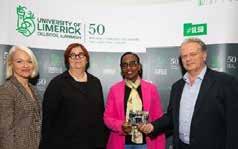
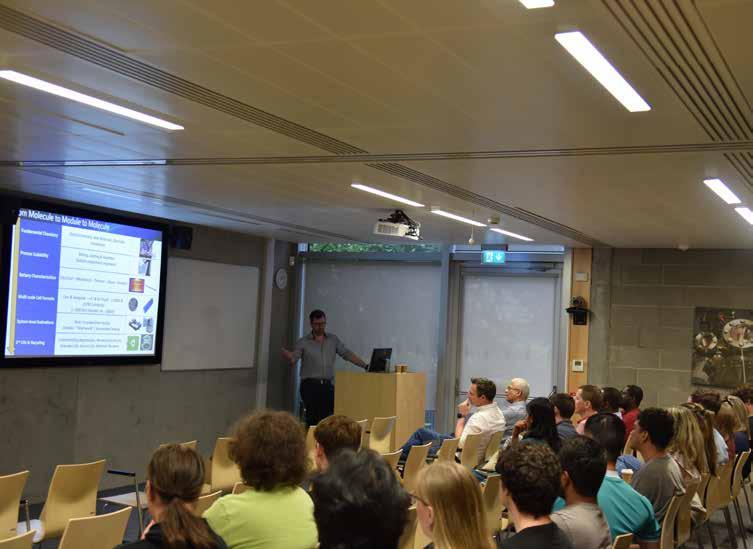

The Bernal Institute hosts a vibrant, regular seminar series, where leading researchers, both internal and external, present their research work to the institute and to the university. The seminar series provides researchers with the opportunity to engage with leading invited speakers, their research groups and home institutes, thereby stimulating national and international collaborations. In the period January 2022 to June 2023, 61 seminars were held, with 29 speakers from abroad, 19 from UL and 13 from the rest of Ireland.
Presentations have been hosted from academic peers ranging from a wide variety of organisations, including University College Dublin, Queen’s University Belfast, Trinity College Dublin, Bechtel Ireland, University of Strasbourg, University of Palermo, Imperial College London, Norwegian University of Science and Technology, Technical University of Liberec, Polish Academy of Sciences, Cornell University, Indian Institute of Technology, University of Oxford, University of Toronto, University of Calabria, University of Warwick, University of Bristol, Technical University of Denmark and others. Many diverse topics spanning the institute’s four research clusters: Composite Materials, Bio Materials, Molecular and Nano Materials and Process Engineering, have been presented. Dr

The kick-off meeting for the launch of the SiGNE project, led by Prof. Kevin M. Ryan, with collaborators Dr Hugh Geaney and Dr Tadhg Kennedy, was hosted by the Bernal Institute on 13/14 October 2022. SiGNE (‘Composite Silicon/Graphite Anodes with Ni-Rich Cathodes and Safe Ether based Electrolytes for High Capacity Li-ion Batteries’) is an €8 million Horizon Europe project, with 16 partners in total from all over Europe. The partners include seven researchperforming organisations (UL, KIT, ZSW, DLR, CID, FSU-Jena and U Roma) and ten industry partners (Ferrari, TES-AMM, CRF-Stellantis, SVOLT, Analog Devices, TMEC, TMEC PL, Sidrabe, Delfort and Solvionic) across eight countries in Europe in addition to Ireland (Germany, Spain, France, Italy, Austria, Poland, Ukraine and Latvia).
The objectives of SiGNE are to deliver an advanced lithium-ion battery (LIB) for electric vehicles (EVs) that will deliver higher energy (50% increase, both specific and volumetric) and greater power density (300% increase) in an equivalent pack size to that of commercial cell chemistries. This will be achieved by materials development at component level of the battery of anode, cathode, separator and electrolyte, which are optimised for rapid transition to prototype development and manufacturing, with a minimal environmental footprint. The advances obtainable with this technology will translate to a 50% range enhancement for EVs with a similar pack size. In real terms, this would push the maximum range from 540 km (higher end of what is currently available) to 810 km, similar to that of an internal combustion engine with a full tank. The technology will be cost competitive and allow for fast charging and an extremely long and stable cycle life that will facilitate significant second use of the batteries beyond the lifetime of the car.

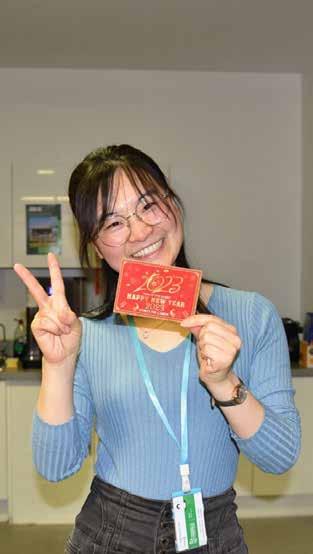
The Bernal Institute is home to over 400 staff and students from a diverse range of cultures and backgrounds. As such, the establishment of an Equality, Diversity and Inclusion (EDI) committee that would recognise and address our strengths and weaknesses in promoting EDI in Bernal was of the utmost importance.
The Bernal EDI Committee was established on the 8 December 2022. Comprising Rebecca Corbett (Chair), Jon O’Halloran, Sarah Hayes (SSPC), Samuel Solomon, Jacky S Bouanga Boudiombo, Fernanda Zamboni, Anne Beaucamp McLoughlin, Jack O’Callaghan, Mahmoud Ranjibar and Caitríona Hickey, the committee met and agreed to work together to drive change, challenge issues and take action. This involves the design and introduction of initiatives that will create an engaging, multicultural and diverse learning and work environment for all. A calendar containing all events planned by the EDI Committee for the coming academic year was issued to the community. The first of these, the celebration of Chinese New Year, took place a month after the committee’s formation and was a great success, having one of the strongest attendances post-pandemic for a Bernal event. Our Chinese colleagues shared their food and traditions and the event was a promising precursor to future planned events for 2023 such as Iranian New Year and Mental Health Awareness Week.


The success of the Bernal annual research day, AStruM 2022, held on 26 April, was undoubtedly the highlight of the first and second quarter. The year’s theme, ‘Towards a Circular Economy’, was chosen to inspire and encourage our students to tailor their own research to work towards a resilient systems solution framework that tackles global challenges like climate change, biodiversity loss, waste and pollution. Initiating proceedings on the day in a near capacity auditorium, was our keynote speaker, Ossian Smyth TD, Minister of State at the Department of Public Expenditure and Reform, with responsibility for Public Procurement, eGovernment and Circular Economy. Minister Smyth, in his keynote speech, detailed his party’s newly launched Circular Economy. This innovative strategy highlights how saving energy and being energy efficient are critical for the climate; how we need to think this way about our material resources, like food, metals, plastic and concrete; and how we can achieve this through a circular economy. The strategy provides a really important policy signal across the public and private sectors that circularity belongs at the heart of sustainability.

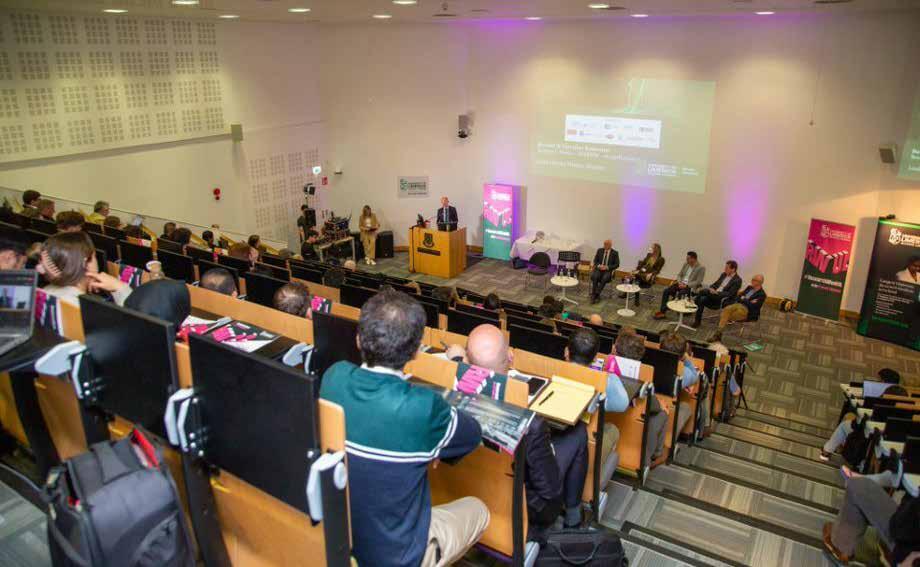 Dr Sousa Javan Nikkhah showcasing her work to her fellow colleagues for the Poster Competition
Dr Sousa Javan Nikkhah showcasing her work to her fellow colleagues for the Poster Competition
In addition to the keynote address, the day was filled with many interesting speakers and representatives from the world of industry and academia. Speakers from Boston Scientific, ESB, Becton Dickinson and Analog Devices, to name a few, held an engaging fireside discussion about the theme of the day, while parallel sessions with invited guest speakers from each of the Bernal Clusters were held in virtual seminars.
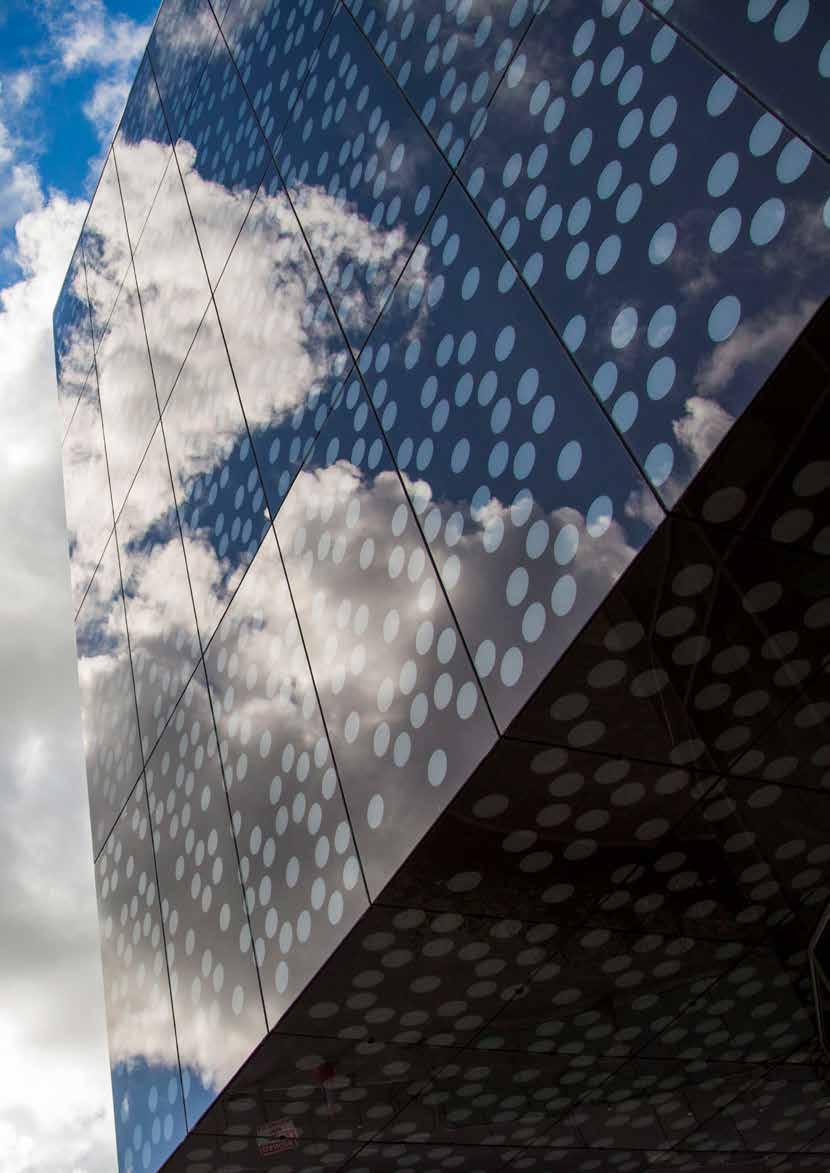
Finally, the day was brought to a close with the ever-popular presentation of the Bernal Awards, ranging from the winners of the Thesis in Three, the Research Image and Poster of the Year, the Safety Initiative Award for the labs, the Post Doc of the year, and of course, the much-coveted Researcher of the Year awards. Out of the many strong contenders for Researcher of the Year, the awards finally went to Prof. Kevin Ryan, Research Leader of the Year; Prof. Maurice Collins for Senior Researcher; and Dr Matthias Vandichel for Early/Mid-Career Researcher. Given the strength of research in Bernal during 2021/2022, the winners of the year’s awards just pipped the post with their outstanding achievements in 2022.

The Bernal Institute continues to grow in popularity as a venue for conferences and other events hosted by both UL colleagues and external parties. Below are some of the events held during the reporting period:
• Implementation Science Conference, ‘Complexities and Challenges’ – Health Research Institute.
• Matrix Biology Ireland Annual Conference
• Knowledge Day – Pharmaceutical Manufacturing Technology Centre.
• Youthreach Ireland STEAM (Science, Technology, Engineering, Arts and Maths) Day –SFI Research Centre for Pharmaceuticals, SSPC and National Youth Council of Ireland. Participating students were invited to present their work for a day of exhibitions, workshops and talks.
• Society of Aircraft Performance and Operations Engineers (SAPOE) Annual Conference. The hybrid-format conference was hosted by the Bernal Institute, with support provided by the School of Engineering. Aviation sustainability was a key topic.
• Early Career Researcher Symposium – SFI (SSPC).

• Inaugural lecture, ‘Designing molecular materials for health and sustainability’ – Prof. Damien Thompson, Chair of Molecular Modelling.
• Inaugural lecture, ‘Structure and function of thermophilic cytochrome C oxidases: the biosynthesis of water’ – Prof. Tewfik Soulimane, Chair of Molecular Structural Biology.
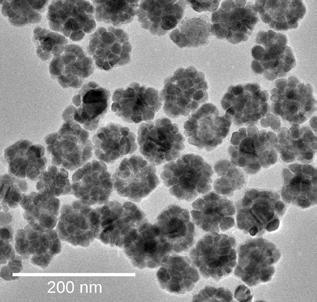
52


The Bernal Enterprise Services Team (BEST) is dedicated to managing the institute’s interaction with industry for accelerating research and innovation. We offer a complete managed service, including legal agreements, accounts and project management, ensuring a smooth delivery of service. Typical interactions can be categorised as: facilities access, consultancy services (up to one day per week per staff academic), technical support, training and projects.
The services team are a first contact point for industry-based organisations to access the benefits of knowledge and infrastructure through over 400 research personnel, including professors, PhDs, postdoctorates, SFI-funded investigators, instrument scientists and over €50 million in research infrastructure, all in one place.
The Instrumentation team is led by Dr Serguei Belochapkine, our dedicated team of instrument scientists have extensive experience in meeting the analytical needs of a wide variety of industries. Bernal is uniquely positioned with a retention of knowledge that is accessible through the aforementioned interactions such as the facilities access agreements.
Fionnuala O’Connell
Fionnuala O’Connell is the Industry Liaison with Bernal Enterprise Services. Fionnuala interacts with industry and external academic institutions on a daily basis and partners with the academic and research community within the Bernal Institute to deliver solutions to their challenges. Fionnuala links and guides external contacts through the university’s complexities, simplifying engagement, identifying collaborative opportunities, coordinating action and managing projects



For a detailed list of equipment at the Bernal, go to https://attlas.ie

Ray is the Bernal Institute Business Development Manager and Marketing & Communications Manager. With over 22 years in industry, he has brought a customer-focus mindset to industrybased interactions, with a proven track record of driving growth and fostering strategic partnerships, some of which include:

A selection of the instruments available within Bernal include
• X-ray photoelectron spectroscopy (XPS)
• Transmission Electron Microscopy (TEM)
• Scanning Electron Microscopy – Focussed Ion Beam (SEM-FIB)


• Time of Flight Secondary Ion Mass Spectrometry (ToF-SIMS)
• MALDI-ToF Ultraflextreme Mass Spectrometry

• Perkin Elmer Spectrum 100 FTIR Spectrometer
• Nanoindenter

Attlas is an industry specific repository of accessible analytical services in the Bernal Institute.
BEST hosted its annual Industry Day on 7 December 2022. The theme of the day was ‘Opportunities for the Future’ and the event was a unique opportunity to understand and engage with the research landscape from an industrial perspective. Attendees:


• Heard from company practitioners on their successful collaborations to date.
• Learned how they have leveraged Bernal resources (equipment and people) to accelerate their strategic outcomes.
• Participated in live demonstrations delivered by Bernal’s dedicated team of instrument scientists.
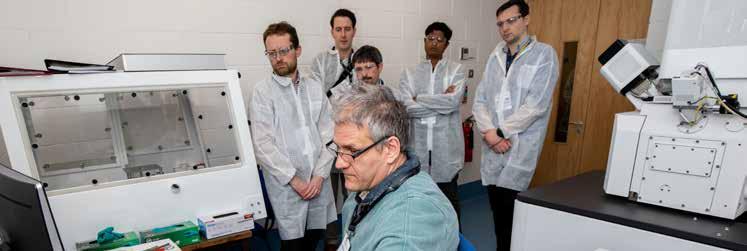
• Connected with Bernal’s industry-relevant talent pipeline.
• Walked through a selection of Bernal’s 91 state-ofthe-art labs and observed its equipment in action.
The day consisted of a fireside event on Opportunities for the Future, that brought representatives from Industrial Development Agency: Barry O Sullivan; Shannon Foynes Port Company: Jerry Hallissey; ESB: Aodhan McAleer; Boston Scientific: Laura Gamez; our own Prof. Ann Ledwith, UL and Vice President of Research, Prof.
Norelee Kennedy. Our thanks to our MC, Catriona Tierney. Following on from this, a tour of the facilities was given, followed by a talk on funding from an industry perspective. This attracted speakers from Analog Devices: Mike Morrissey; Boston Scientific: Sean Cooney; Serosep: Emma Morgan; and Bernal’s Prof. Kevin M. Ryan on Horizon EU.
In conjunction with the Technology Transfer Office, the institute also launched a six-week entrepreneurship programme in November for the Bernal community. The programme’s aim is to foster an entrepreneurial culture, drive commercialisation and actively support start-up initiatives. The programme will connect Bernal researchers with subject matter experts in commercialisation, funding, intellectual property, investors and career management, who will share their experience, lessons learned and advice on transforming research into viable commercial activities and/or businesses.
The Bernal Enterprise Services Team (BEST) is extremely grateful to our partners who sponsored this event: Analog Devices, Boston Scientific, Serosep, Becton Dickinson and Eli Lilly.
At the Pharmaceutical Manufacturing Technology Centre (PMTC), we harness the value of collaboration, first by identifying industry challenges and then transforming them into opportunities. This is achieved through targeted research that delivers value to the sector, leveraging both academic talent and Ireland’s indigenous SME network. PMTC has a wide range of capabilities and extensive domain experience, ensuring we can remain relevant, agile and highly responsive to the unique and growing needs of our member companies. Our team of experienced postdoctoral researchers support companies across the biopharmaceutical manufacturing sector, in optimising their manufacturing facilities within the framework of our three core research areas:

1. Pharmaceutical plant cleaning (including containment, changeover and verification)

2. Process control and optimisation
3. Data analytics and utilisation.
In 2022, PMTC competitively won €1.5 million in funding, including an Enterprise Ireland Commercialisation Fund totalling over €172,000, over €370,000 in Innovation Partnership programmes and an SFI-funded Frontiers for the Future grant totalling over €900,000.
June 2022 saw the implementation of Ireland’s only ATEX Clean-In-Place (CIP) skid. Situated in PMTC’s laboratory within the Bernal Institute, the skid is fully automated and equipped with PAT (process analytical technology) tools and sensors for real-

time monitoring and verification of the cleaning process. It also allows the testing of cleaning methods on all types of construction materials used in industry, including stainless steel, Hastelloy, glass and teflon. As the skid was customised using industrial standards, the learning and outcomes can be easily translated to industry.
In November 2022, PMTC welcomed over 170 delegates to our annual Knowledge Day, a hybrid event held at Bernal. Delegates were provided an excellent opportunity to engage and network with experts and peers alike. While the focus of the event is to disseminate the breadth of research undertaken and to share knowledge across our wide network, Knowledge Day 2022 also explored future research opportunities through dynamic industry–academic panel discussions.
PMTC, with support from IDA Ireland and Enterprise Ireland, also used Knowledge Day to launch a report outlining the current position and future needs of the Pharma sector in Ireland. The report, Delivering
for Ireland’s Pharmaceutical Industry, identified clear trends and challenges, while also pinpointing how supports can be matched to meet them. The results of the study paint a positive picture of a pharmaceutical manufacturing ecosystem that is expanding and building on its strong track record, reputation and innovative culture. The report has been distributed to PMTC industry members and is available to the public at www. pmtc.ie.
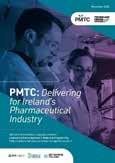
Finally, PMTC was honoured to be recognised by the industry for both excellence and impact delivered to the Irish pharmaceutical industry at the Pharma Industry Awards 2022. PMTC was shortlisted in five categories and won two awards, Pharma Research Centre of the Year and Pharma Project of the Year, ‘Small: ATEX Rated Clean-inPlace Facility’.

The Dairy Processing Technology Centre (DPTC) is a €34million Enterprise Ireland-funded facility, made up of an industry–academic collaboration of seven dairy processing industry partners and six academic organisations. The DPTC focuses on supporting Irish dairy processors in becoming global market leaders of sustainable, quality dairy ingredients. In achieving this overall goal, the DPTC aims to deliver value to our industry partners through the accelerated adoption of new technologies, de-risking of investment decisions, enhancing the dairy processing knowledge base and delivering both short- and long-term wins.
The DPTC has had exceptional participation and dedication from our academic and industrial partners throughout what has, at times, been a difficult year for the sector. Alongside inflation, supply chain challenges, labour shortages, climate change and ongoing changes to regulations, the DPTC has continued to address and support industry challenges, helping to position and drive growth, resilience and sustainability within the sector.

Two research focus areas make up the DPTC. RFA1 examines milk-composition driven adaptive processing and RFA2 focuses on sustainable milk processing.
• RFA1: The development of adaptive processing strategies in response to inherent milk variability has the potential to profoundly impact dairy processors in the near and long term. DPTC’s programme of predictive and adaptive processing will optimise processing performance, improve plant performance and increase the control of product-functional properties and finished-product characteristics.

• RFA2: The long-term sustainability of the Irish dairy processing industry will be enabled by a system change along the entire processing chain. From milk intake to effluent discharge, RFA2 research aims to minimise energy and water consumption, and to valourise low-value process streams and waste streams to produce renewable energy and nutrient resources. In response to industry needs, and informed by a detailed compositional analysis of the various waste streams, RFA2 seeks to maximise these opportunities for the benefit of DPTC industry members.
The Sustainability Innovation Forum (SIF) and the Emerging Contaminants Forum (ECF) have been established by the DPTC. These fora support the DPTC research agenda, giving our community the chance to collaborate with outside specialists, while extending the scope of DPTC research.
The SIF aims to develop ideas to support sustainable measures in dairy processing, to identify solutions by connecting technology and knowledge providers with members, and to provide knowledge-sharing and educational events. In 2022, the SIF hosted a number of information sessions and explored funding avenues to address decarbonisation issues for our industry partners.
The ECF enables DPTC members to give an industry-led, coordinated, and consistent voice to the regulatory authorities (via industry groups), while presenting a joint Dairy Ireland strategy to evaluate the growing list of limits arising from legislation or consumer requirements.

The DPTC aims to achieve a 1:1:1 funding model (EI:industry:external) by 2025. Our total externally
awarded funding currently stands at €9 million. The original target of €7.82 million over five years was surpassed in Year 3, thanks to a huge commitment by the PIs, researchers and industry partners involved. Through our funding strategy, we aim to support translation of our research for industry. The sources of this funding encompass the major Irish and EU funding bodies, from Horizon Europe, e.g. Super-COMPF Eurostar (Prof. Tom Curran, UCD) and Interreg BIOWILL (Prof. JJ Leahy, UL), to SFI, EI and DAFM, e.g. Photocatalysis and hydrodynamic cavitation (Prof. Vivek Ranade, UL).
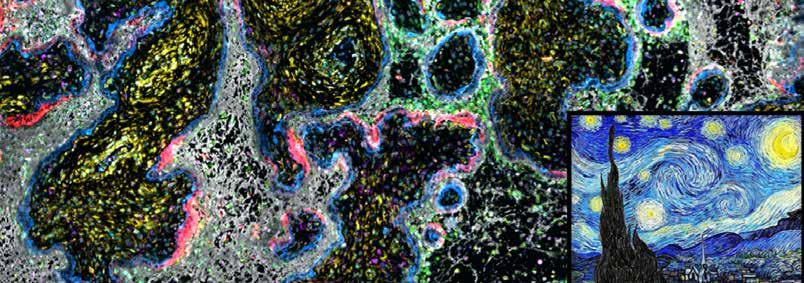
During the year, we participated in a number of external promotional and networking events to showcase the ongoing research of the centre. These included attendance at the Enterprise Ireland Innovation Arena, the Ploughing Championships, and hosting the Bord Bia International Dairy Buyers Visit. The DPTC Knowledge Day 2023, ‘Digitalisation for Sustainable Manufacturing’ (March 2023) focused on digitalisation journeys throughout the Industry 4.0 roadmap and beyond, and provided an opportunity for the business and academic worlds to connect and explore the potential of digitalisation for sustainable dairy processing. Our DPTC Research Theme Day 2022, which focused primarily on our early-career researchers, also helped to showcase our core research programme, while at the same time pushing our talent development strategy for emerging dairy researchers.
Finally, we are happy to have launched the Associate Membership Model and currently have five Associate Members. The model provides a unique opportunity to validate technologies and solutions for the dairy processing industry, working alongside world-leading researchers in process engineering.
SSPC, the Science Foundation Ireland (SFI) Research Centre for Pharmaceuticals, is a global hub for (bio)pharmaceuticals, developing design rules and blueprints using fundamental science to create better and safer materials, integrated with faster, leaner, more agile manufacturing processes. SSPC works closely with research partners, leveraging the best collaborative science to address grand challenges in health and sustainability. SSPC is led by Scientific Director, Prof. Damien Thompson, who is also Professor of Molecular Modelling at UL, and will be celebrating 15 years of impact from June 2023.
SSPC collectively comprises over 230 researchers from nine institutions across Ireland working with >50 industry partners worldwide. Through sustained state support and by leveraging significant additional funding through national and international partnerships, SSPC are doing research at a scale that can influence all phases of pharma and biopharma, from preclinical development through to manufacturing and life-cycle extension.
SSPC has increased its international status, with strong investigators, highly cited publications, collaboration with international industry partners and early career researchers who are being trained for global positions. SSPC’s research themes and expertise add new skillsets that are having an impact on the centre, allowing SSPC to work at the interface of small- and large-molecule research. These more than 200 projects are pushing the boundaries of possibility, with eco-friendly, affordable pharmaceutical materials, spanning from small-molecule drug co-crystals to monoclonal antibodies. Controlling their molecular properties allows effectiveness and biocompatibility beyond what is possible with existing materials.
This year, SSPC is working on 29 collaborative industry projects, 16 international collaborations are underway through industry membership/projects, and five leading biopharmaceutical companies
are collaborating with SSPC on a multi-industry project. The centre expanded its membership to include a further seven industrial members, and 22 researchers were successfully placed on secondments across ten industry sites in 2022.

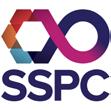
SSPC has an excellent track record of publishing in partnership with industry. In 2022, a total of 14 joint industry publications arose from our member and non-member project collaborations. Overall, 45% of the 131 publications in 2022 are in the top decile and 88% are in the top quartile.
A total of €4.5 million NE:NC (Non exchequer:Non Commerical) competitive EU, philanthropic and other-source awards were won, with female investigators accounting for 54% of these. The centre’s global reach includes 33 funded global partnerships involving over 90 higher education institutions, 25 research organisations, 60 industry partners and 25 policy and regulatory groups. This reach spans the EU, United States, China, United Kingdom, Switzerland, Norway, and Korea. SSPC is leading on international engagement, which is evident in SSPC’s targeted industry project programme, with 35% of all projects collaborating with corporate R&D international sites.
Significant wins in 2022 include the European Research Council and SSPC playing a prestigious leadership role in the Marie SkłodowskaCurie Actions project and in the area of green pharmaceuticals manufacture and disposal. This is central to the EU’s green agenda and feeds into SSPC’s remit of sustainable and competitive pharmaceutical manufacturing.
SSPC’s Education and Public Engagement (EPE) programme is grounded in research for science education, informal and non-formal learning, methodological design and interest-based pedagogies. SSPC offers a variety of training across EPE activities, and through this, instils its societal values and impact in the community.


Hamid Hafizi (Maurice Collins)
Spyridon Alexandratos (Noel O’Dowd)
Mohammad Ansari (Paul Weaver, Giovanni Zucco)
Aileen Bowen Perez (Paul Weaver, Giovanni Zucco)
Sean Carey (Paul Weaver)
Gearóid Collins (Kevin Ryan, Hugh Geaney)
Chiara De Benedictis (Andreas Grabrucker)
Molly Haskins (Michael Zaworotko)
Seamus Kilian (Kevin Ryan, Tadhg Kennedy)
Rob Lehane (Micheál Scanlon, Edmond Magner)
Gearoid Mangan (Andy Stewart, Damien Thompson)
Kieran McCarthy (Tadhg Kennedy, Kevin Ryan)
Adrien Mouchard (David Tanner, Michael Pomeroy, Jeremy Robinson)
Nastaran Nourmohammadishishvan (Paul Weaver, Noel O’Dowd)
Solomon Obadimu (Kyriakos Kourousis)
Siobhan O’Connor (Emmet O’Reilly)
Niall Coughlan (Ning Liu)
Padraig Fitzmaurice (Gavin Walker, Ehab Romeih)
Alex Huddlestan (Teresa Curtin, Seamus Clifford)
Daniel O’Hearn (Michael Zaworotko)
Noel O’Sullivan (David Tanner)
Fernando Otero (Edmond Magner, Tofail Syed, Urszula Salaj-Kosla)
Italo Pisano (JJ Leahy, Witold Kwapinski)
Philip Poillot (Jacques Huyghe)

Indraneel Roy Chowdhury (Anthony Comer, Noel O’Dowd)
Aoibhín Ryan (Sarah Hudson, Damien Thompson)
William Scalbert (David Tanner)
Kim Leah Shortall (Edmond Magner, Tewfik Soulimane)
Samuel Solomon (Ahmad B Albadarin, Gavin Walker)
Dylan Storan (Kevin Ryan, Hugh Geaney)
Liam Whitmore (Elizabeth Ryan)
Hui Zhang (Ning Liu)
Yongliang Zhang (Ning Liu, Christophe Silien)
Niall King (Gavin Walker)
Neil Mulcahy (Ursel Bangert)
Edgar Ramirez Huerta (Maurice Collins)
Bernal members produce a range of publications that convey the pioneering research underway at the institute and represent a sizeable majority of UL’s total publication output. They also publish in a range of high-quality journals, a sample of which is given below.

The equipment and facilities mentioned in this document have been co-funded by the European Regional Development Fund (ERDF) under Ireland’s European Structural and Investment

Funds Programmes and the HEA, the European Commission, Science Foundation Ireland, Enterprise Ireland, IDA Ireland, The Atlantic Philanthropies and Analog Devices.








